Physical Address
304 North Cardinal St.
Dorchester Center, MA 02124
The CNS consists of the brain and spinal cord.
The brain is composed of the cerebrum, brainstem, and cerebellum.
The cerebrum consists of two cerebral hemispheres. Each hemisphere presents a central core that is composed of basal ganglia and diencephalon. The basal ganglia consist of a group of telencephalic subcortical nuclei (caudate nucleus, putamen, globus pallidus, subthalamic nucleus, and substantia nigra; the putamen and globus pallidus are collectively called the lentiform nucleus). The diencephalon is composed of the hypothalamus, dorsal thalamus or thalamus, ventral thalamus or subthalamus, and epithalamus (pineal gland, habenular nuclei and habenular commissure, and stria medullaris thalami). The insula is the lateral covering of the central core. Each central core communicates with its mate via anterior and posterior commissures, massa intermedia, and habenular commissure. The hypothalamus and thalamus of each side form the lateral wall of the third ventricle.
The central core is supplied by lenticulostriate, thalamoperforating, and choroidal arteries, and is drained by basal and internal cerebral veins.
From its depth to its surface, each hemisphere presents a series of C-shaped structures that will successively wrap around the underlying structure: wrapping around the central core are the fornix and choroidal fissure; the lateral ventricle wraps around the fornix and choroidal fissure; the white matter (projection and association fiber systems) encloses the lateral ventricle, being the corpus callosum as the main component of the roof of the lateral ventricle; the limbic gyrus (cingulate and parahippocampal gyri) is another C-shaped structure that wraps around the lateral ventricle, being separated from the latter by the white matter system; the whole system is finally wrapped by the sulci and gyri of the frontal, temporal, parietal, and occipital lobes. These lobes are supplied by internal carotid, anterior cerebral, middle cerebral, and posterior cerebral arteries, and drained via superficial veins toward the adjacent venous sinuses.
Before the enfolding process of the cerebrum surface to form the sulci and gyri, the arterial branches were located on the surface of the cerebrum; with the enfolding process, a great deal of cerebrum and the arterial branches will become hidden inside the sulci.
The central core continues inferiorly with the brainstem, consisting of the optic tract, lateral and medial geniculate bodies, pulvinar of the thalamus, and the pineal gland as the inferior limit of the central core.
The brainstem consists of midbrain, pons, and medulla oblongata; they connect with the cerebellum respectively through superior, middle, and inferior cerebellar peduncles.
The brainstem connects inferiorly with the spinal cord and superiorly with the central core by means of projection fiber systems.
The brainstem and cerebellum are supplied by the vertebrobasilar system and branches: the vertebral, posterior inferior cerebellar, basilar, anterior inferior cerebellar, and superior cerebellar arteries. The draining veins of the brainstem and cerebellum course toward the vein of Galen (superior group), or toward the superior petrosal sinus (anterior group), or toward the transverse sinus (posterior group).
There are 12 pairs of cranial nerves (CNs): CNs I and II are related to the cerebrum; CNs III and IV are related to the midbrain; CNs V, VI, VII, and VIII are related to the pons, and CNs IX, X, XI, and XII are related to the medulla oblongata. CN XI also has a spinal component.
It is our belief that successful microneurosurgery is based on six solid foundations: (1) anatomic knowledge; (2) capability of understanding the information provided by imaging and correlate it with anatomy; (3) capability of planning the surgical strategy based on the anatomic and radiologic correlation; (4) capability of bringing together the anatomy, imaging, and presurgical planning into the surgery; (5) fine surgical skill developed through extensive training (probably the best way to refine surgical skill is to perform frequent microsurgeries); and (6) a good anesthesiologist, adequate instruments, and when necessary, intraoperative neurophysiologic monitoring and imaging guidance system.
Comprehensive knowledge of anatomy is critical for successful neurosurgery. The history of the scholarly analysis of the brain anatomy is longstanding, and despite beliefs to the contrary, study of brain anatomy continues to be vigorously pursued even in the third decade of the 21st century.
The anatomy of the brain from different angles is the key to assembling an authentic tridimensional knowledge. As important as the knowledge of the surface anatomy and the anatomy of the deeply located structures is the establishment of the correlation between them. This correlation will empower us to have an “X-ray vision” or “see-through vision” that will enable us to see the depths of the brain through its surface.
The arteries and veins make up the “skeleton” of the brain, and it is through the angiogram that we “see” its intricate vascular anatomy. However, angiography has the true “see-through” or “X-ray vision” capability, as it reveals all vessels in different layers from front to back in that particular projection, and this requires that we also know the anatomy of the main projections in the cerebral angiogram from front to back. The angiogram is the road map of the brain; we need to understand not only the names of the vessels, but also their exact location, their relationship to the surrounding structures, and how to surgically approach them.
In this chapter we endeavor to accomplish, at least to some extent, the first two foundations by exposing the surgical anatomy of the neural and vascular structures of the cerebrum and cerebellum. It will be reviewed following the sequence: (1) lateral, (2) basal, and (3) medial surfaces of the cerebrum; (4) white matter fibers; and (5) posterior fossa. A more in-depth study of the anatomic-angiographical correlation, especially in the posterior fossa is presented. In the web-based version, we present more than 22 hours of intraoperative videos of 67 microsurgical procedures ( Table 2.1 ) for a wide variety of brain disorders. These videos also contain radiologic studies and correlated anatomic specimens. In each case, this additional information provides an understanding of the rationale behind our choice of surgical approach to the lesion. In many of these videos, we also discuss alternative approaches and outline why such approaches are not as optimal. Our ultimate goal is to expand and augment the reader’s fundamental neuroanatomic knowledge. With such knowledge, the foundations of microsurgery can be realized.
| Video | Lesion and/or Approach | For Additional Information, See Chapter |
|---|---|---|
| Resection of right frontal focal cortical dysplasia | Chapters 79 and 95 | |
| Transsulcal approach to right frontal glioblastoma | Chapters 151 and 159 | |
| Postcentral sulcus approach to left parietal cavernoma | Chapter 461 | |
| Transsulcal approach to left parietal glioblastoma | Chapter 159 | |
| Left precentral gyrus dysembryoplastic neuroepithelial tumor (DNET) | Chapters 158 and 237 | |
| Left fronto-parietal opercula grade 2 oligoastrocytoma | Chapters 158 and 237 | |
| Central lobe AVM | Chapter 455 | |
| Transsuperior temporal sulcus approach to left temporal glioblastoma | Chapter 159 | |
| Left occipital AVM | Chapter 455 | |
| Technique for opening the sylvian fissure and basal cisterns | Chapter 435 | |
| Pretemporal approach to basilar bifurcation aneurysm | Chapter 435 | |
| Right sylvian fissure AVM | Chapter 455 | |
| Right anterior insular cavernoma | Chapter 461 | |
| Right temporo-insular oligodendroglioma | Chapter 158 | |
| Right insular astrocytoma | Chapter 158 | |
| Left insular AVM | Chapter 455 | |
| Left atrium roof astrocytoma | Chapter 158 | |
| Left subcallosal grade 2 oligodendroglioma | Chapters 158 and 170 | |
| Left lateral ventricle (body) neurocytoma | Chapters 170 and 244 | |
| Total callosotomy for refractory epilepsy | Chapters 96 and 99 | |
| Right head of caudate nucleus cavernoma | Chapter 461 | |
| Right pulvinar of thalamus AVM | Chapter 455 | |
| Cortico-amygdalohippocampectomy for temporal lobe epilepsy | Chapters 94A and 94B | |
| Left uncus cavernoma | Chapter 461 | |
| Transchoroidal approach to third ventricle colloid cyst | Chapter 171 | |
| Transforaminal approach to third ventricle colloid cyst | Chapter 171 | |
| Right middle cerebral artery aneurysm | Chapter 440 | |
| Right middle cerebral artery aneurysm | Chapter 440 | |
| Large right carotid artery bifurcation aneurysm | Chapter 437 | |
| Supracerebellar transtentorial approach to parahippocampal gyrus AVM | Chapter 455 | |
| Left large frontobasal AVM | Chapter 455 | |
| Right large carotid ophthalmic aneurysm | Chapter 436 | |
| Right paraclinoid aneurysm | Chapter 436 | |
| Left medial projecting ophthalmic segment ICA aneurysm | Chapter 436 | |
| Left giant paraclinoid aneurysm | Chapter 436 | |
| Right giant carotid ophthalmic aneurysm | Chapter 436 | |
| Left PCom aneurysm | Chapter 437 | |
| Left PCom aneurysm | Chapter 437 | |
| Left PCom aneurysm (intraoperative rupture management) | Chapter 437 | |
| Right choroid plexus of the body of the right lateral ventricle AVM | Chapter 455 | |
| Left anterior choroidal artery aneurysm post embolization | Chapter 437 | |
| Right ACom and anterior choroidal artery aneurysms | Chapters 437 and 438 | |
| Left middle cerebral artery aneurysm (intraoperative rupture management) | Chapter 440 | |
| Transcavernous approach to basilar bifurcation aneurysm | Chapter 442 | |
| Transparietooccipital sulcus approach to cuneus metastasis | Chapter 169 | |
| Transparietooccipital sulcus approach to precuneus and isthmus of cingulate gyrus ganglioglioma | Chapter 161 | |
| Supracerebellar infratentorial approach to posterior parahippocampal gyrus low grade glioma | Chapter 158 | |
| Right anteroinferiorly projected large ACom aneurysm | Chapter 438 | |
| Right anteroinferiorly projected ACom aneurysm | Chapter 438 | |
| Left anteriorly projected ACom aneurysm | Chapter 438 | |
| Left pericallosal (subcallosal) artery aneurysm | Chapter 439 | |
| Transsylvian transopercular peri-insular hemispherotomy for refractory epilepsy | Chapter 99 | |
| Left frontal lobe decortication sparing frontal horn for focal cortical dysplasia | Chapters 79 and 95 | |
| Left anterior petrosal approach for anterolateral pontine cavernoma | Chapter 461 | |
| Supracerebellar infratentorial approach to pontine cavernoma | Chapter 461 | |
| Telovelar approach to inferior and middle cerebellar peduncle | Chapter 461 | |
| Supracerebellar infratentorial approach to pineal tumor | Chapter 164 | |
| Cerebellar (vermian) AVM | Chapter 455 | |
| Anterior petrosal approach to anterolateral pontine cavernoma | Chapter 461 | |
| Supracerebellar infratentorial approach to midbrain cavernoma | Chapter 461 | |
| Pretemporal approach to anterior midbrain (crus cerebri) cavernoma | Chapter 461 | |
| Midline suboccipital approach to aqueduct cavernoma | Chapter 461 | |
| Far lateral approach to lateral medullary cavernoma | Chapter 461 | |
| Transcavernous approach to basilar bifurcation aneurysm | Chapter 442 | |
| Transcavernous approach to basilar bifurcation aneurysm | Chapter 442 | |
| Far lateral approach to PICA aneurysm | Chapter 441 | |
| Transmedullary fissure approach to PICA aneurysm | Chapter 441 |
The cerebrum is arbitrarily divided into five lobes: frontal, parietal, temporal, and occipital lobes and the hidden insula. On the lateral surface, they are limited by the central sulcus, the posterior ramus of the sylvian fissure, the lateral parietotemporal line (from the impression of the parieto-occipital sulcus to the preoccipital notch), and the temporo-occipital line (from the posterior end of the posterior ramus of the sylvian fissure to the midpoint of the lateral parietotemporal line). The cerebrum presents four main sulci that are 100% continuous—the sylvian fissure and the callosal, the parieto-occipital, and the collateral sulci—and it presents two almost continuous (92%) sulci—the central and the calcarine sulci. There are two 100% interrupted sulci: the precentral and the inferior temporal sulci. The central sulcus starts from the medial surface of the hemisphere above the cingulate sulcus and extends on the lateral surface of the hemisphere from medial to lateral, superior to inferior, and posterior to anterior. It usually does not intercept the posterior ramus of the sylvian fissure and leaves a “bridge” connecting the precentral gyrus to the postcentral gyrus known as the pli de passage frontoparietal inferior, opercule rolandique, or subcentral gyrus ( Fig. 2.1 ).
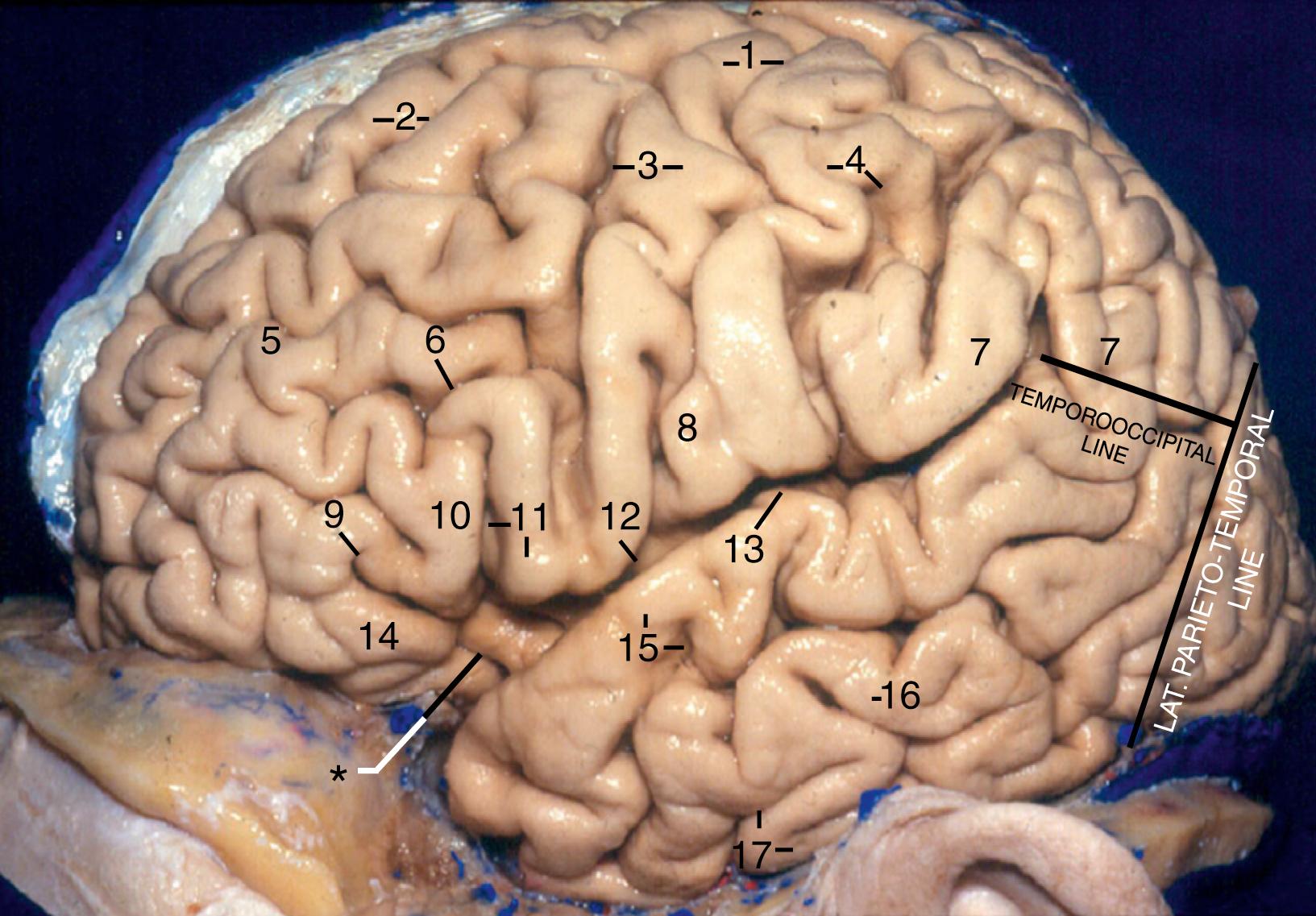
The two main sulci are the superior and the inferior frontal sulci, which are anteroposteriorly oriented and extend from the precentral sulcus to the frontal pole. At their posterior end, these two sulci are intercepted perpendicularly by the precentral sulcus, which has a similar direction as the central sulcus. The precentral sulcus forms the anterior limit of the precentral gyrus. These two frontal sulci divide the lateral surface of the frontal lobe into three gyri: the superior, the middle, and the inferior frontal gyri. The anterior horizontal, the anterior ascending, and the posterior rami of the sylvian fissure divide the inferior frontal gyrus into three parts: pars orbitalis, triangularis, and opercularis. The apex of the pars triangularis is usually retracted superiorly, leaving a space in the sylvian fissure that is usually the largest space in the superficial compartment of the sylvian fissure (see Fig. 2.1 ). The apex of the pars triangularis is directed inferiorly toward the junction of three rami of the sylvian fissure; this junctional point coincides with the anterior limiting sulcus of the insula in the depth of the sylvian fissure, and it marks the anterior limit of the basal ganglia and the location of the anterior horn of the lateral ventricle ( Figs. 2.2, 2.5, and 2.8 ; ![]() eFigs. 2.1 and 2.2 ). This junctional point is projected onto the skull at the pterion (from Greek: “wing”), a region where the frontal, parietal, and temporal bones and the greater wing of the sphenoid bone meet (
eFigs. 2.1 and 2.2 ). This junctional point is projected onto the skull at the pterion (from Greek: “wing”), a region where the frontal, parietal, and temporal bones and the greater wing of the sphenoid bone meet ( ![]() eFig. 2.3 , left ). The intercepting point between the coronal suture and the superior temporal line (stephanion) often is in proximity to the intercepting point between the inferior frontal and the precentral sulci (
eFig. 2.3 , left ). The intercepting point between the coronal suture and the superior temporal line (stephanion) often is in proximity to the intercepting point between the inferior frontal and the precentral sulci ( ![]() eFig. 2.3 , right ). At the intercepting point between the superior frontal and the precentral sulci, the precentral gyrus often presents the morphology of the Greek letter “Ω” (omega), with its convexity pointing posteriorly. This is the most easily identifiable landmark of the motor strip and corresponds to the hand area ( Fig. 2.3 ;
eFig. 2.3 , right ). At the intercepting point between the superior frontal and the precentral sulci, the precentral gyrus often presents the morphology of the Greek letter “Ω” (omega), with its convexity pointing posteriorly. This is the most easily identifiable landmark of the motor strip and corresponds to the hand area ( Fig. 2.3 ; ![]() , ).
, ).
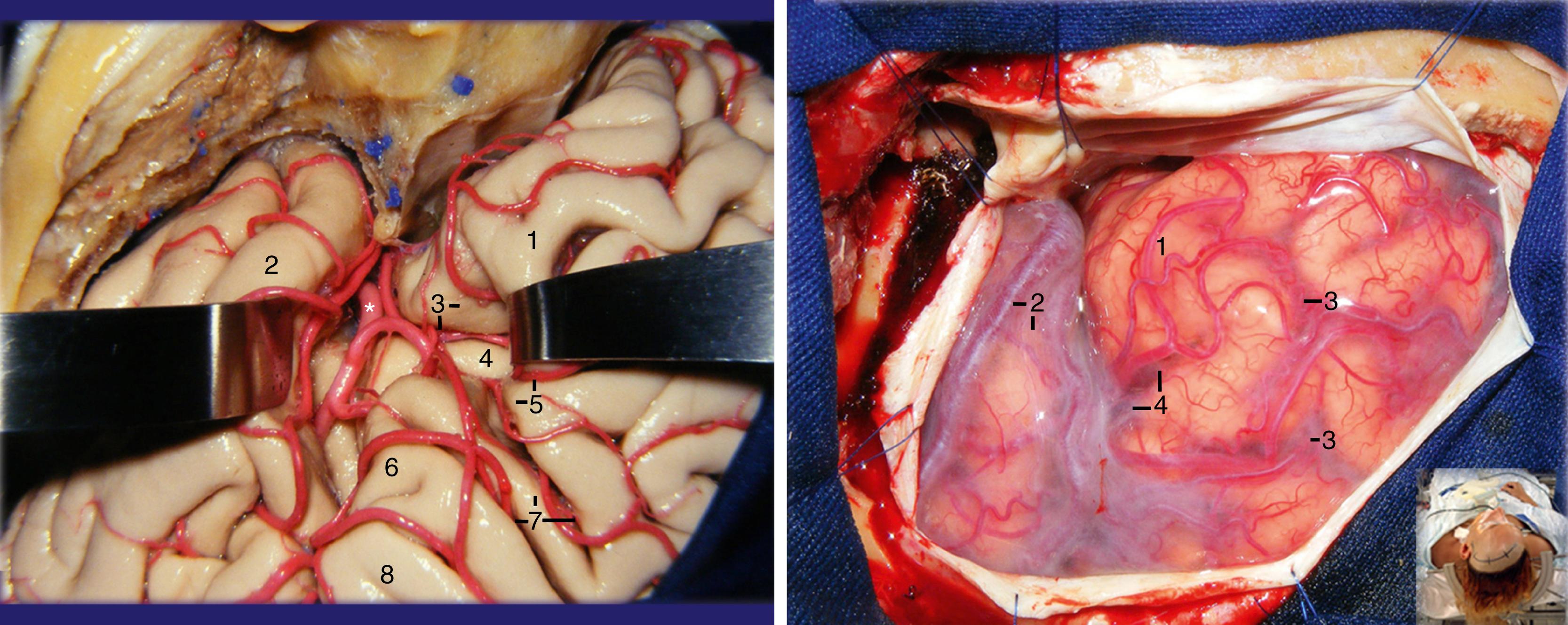
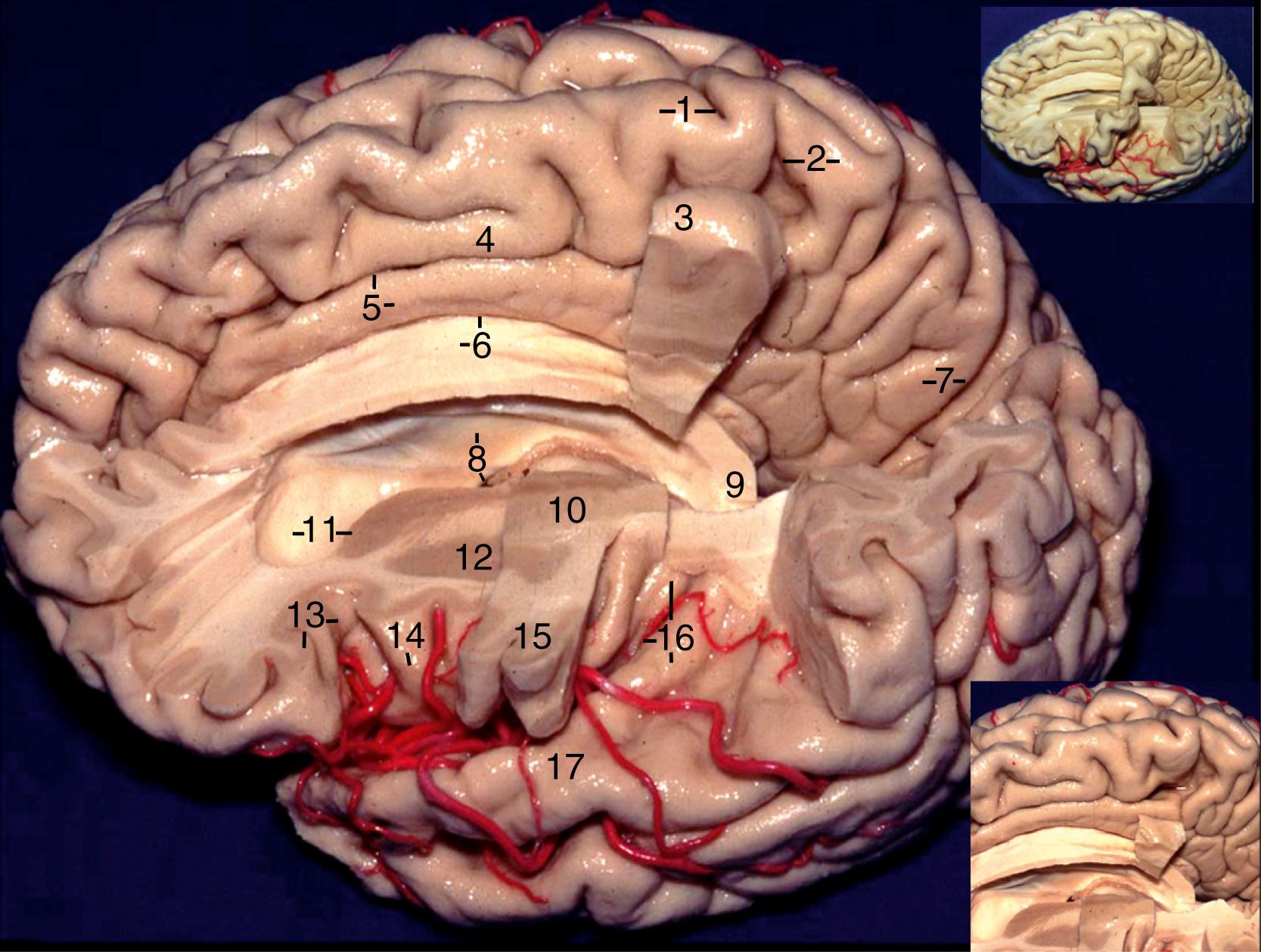
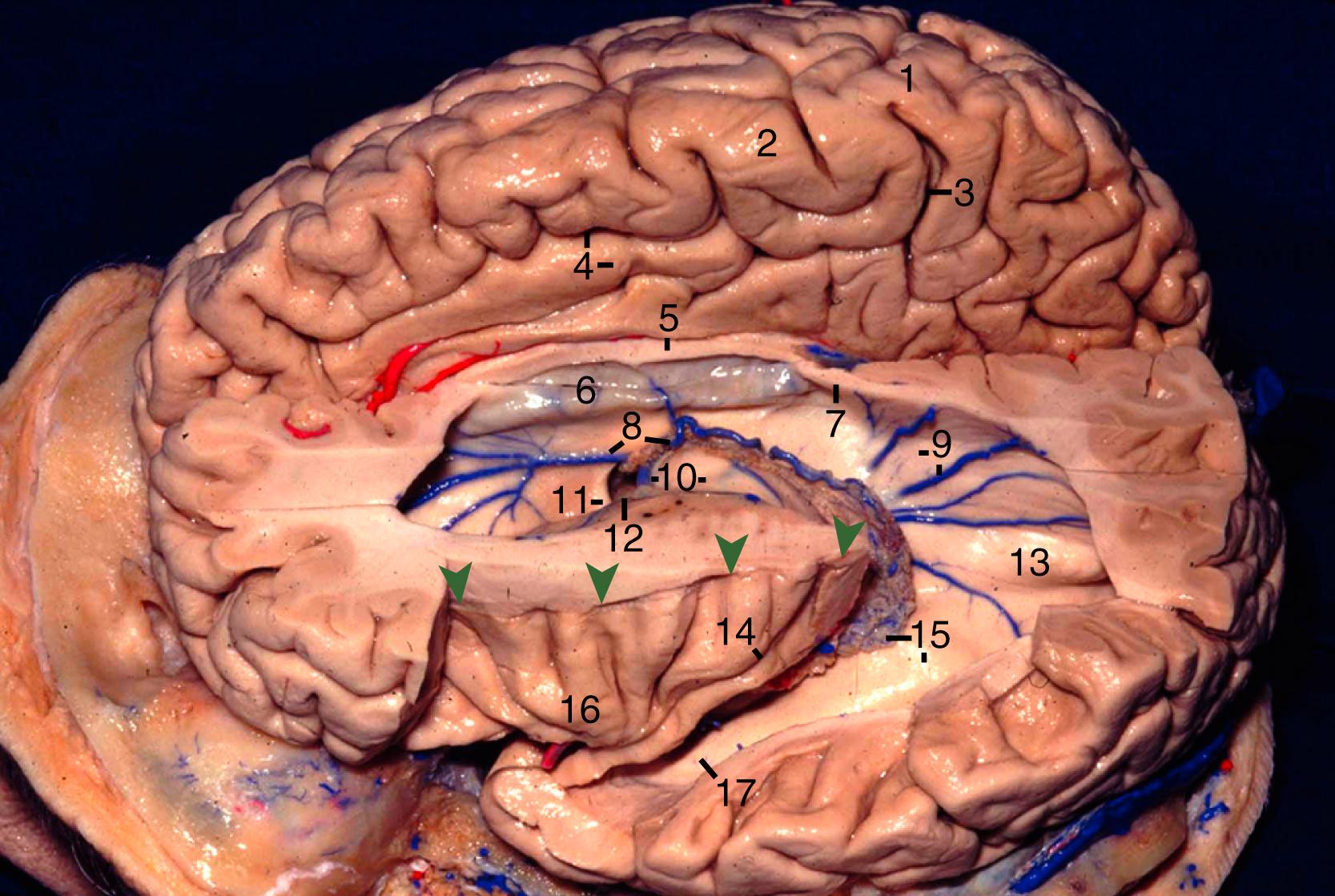
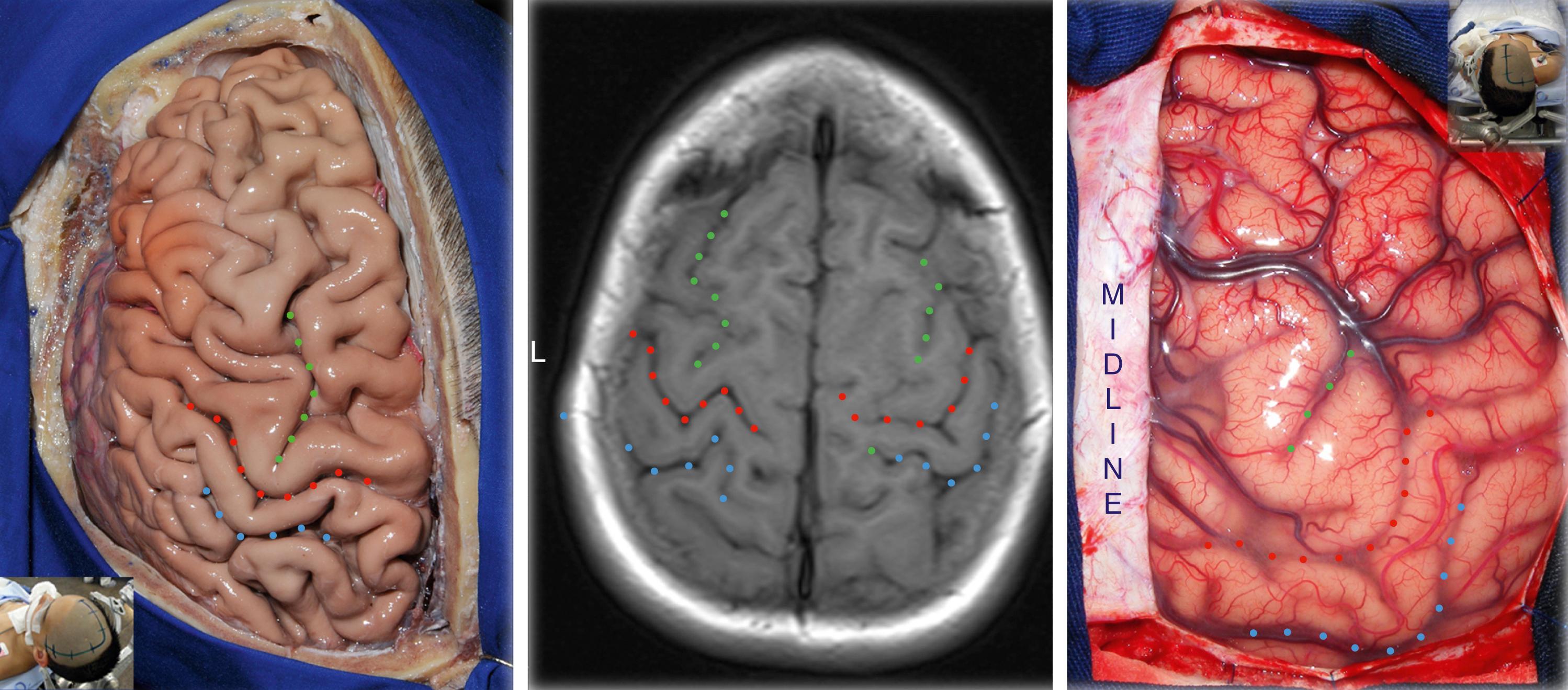
The parietal lobe is limited anteriorly by the central sulcus, medially by the interhemispheric fissure, inferolaterally by the sylvian fissure and the temporo-occipital line, and posteriorly by the lateral parietotemporal line. Its two main sulci are the postcentral and the intraparietal sulci. The shape of the postcentral sulcus is analogous to the central sulcus except for its variable continuity. The postcentral sulcus is the posterior limit of the postcentral gyrus, and sometimes it can be double. The intraparietal sulcus starts at the postcentral sulcus and is directed posteriorly and inferiorly toward the occipital pole; its direction is often parallel and 2 to 3 cm lateral to the midline. The bottom of the intraparietal sulcus is related to the roof of the atrium and the occipital horn. The intraparietal sulcus divides the lateral surface of the parietal lobe into two parts: the superior and inferior parietal lobules. The superior parietal lobule, the superomedial and smaller part, continues as the precuneus in the medial surface of the parietal lobe. The inferior parietal lobule is constituted by the supramarginal and the angular gyri. The supramarginal gyrus is the posterior continuation of the superior temporal gyrus and turns around the posterior ascending ramus of the sylvian fissure. The angular gyrus is the posterior continuation of the middle temporal gyrus and turns superiorly and medially behind the posterior ramus of the sylvian fissure up to the intraparietal sulcus; it is sometimes limited between the two posterior terminations of the superior temporal sulcus, the angular and anterior occipital rami ( Fig. 2.4 ). The postcentral and intraparietal sulci, and the superior parietal lobule are a mirror image of the precentral and superior frontal sulci and the superior frontal gyrus, with the central sulcus as the “mirror” ( ![]() , , , , ).
, , , , ).
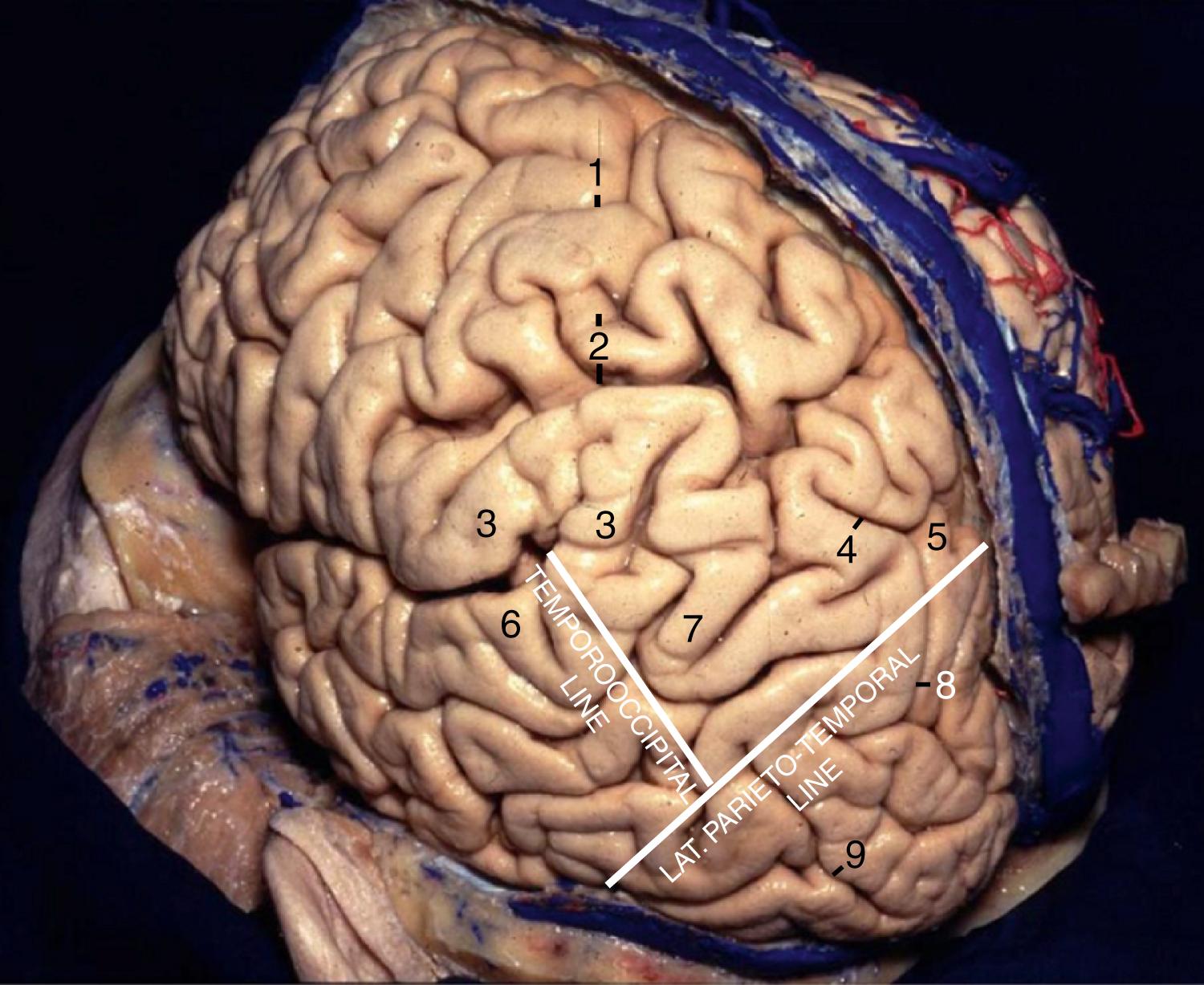
The temporal lobe is limited superiorly by the posterior ramus of the sylvian fissure and posteriorly by the temporo-occipital and lateral parietotemporal lines. It presents two main sulci, the superior and inferior temporal sulci, which divide the lateral surface of the temporal lobe into three gyri: the superior, middle, and inferior temporal gyri. The inferior temporal gyrus occupies the lateral and basal surfaces of the cerebrum. The superior and inferior temporal gyri converge anteriorly to form the temporal pole (see Fig. 2.1 ; ![]() eFig. 2.3 ;
eFig. 2.3 ; ![]() ).
).
The occipital lobe is located behind the lateral parietotemporal line and is composed of irregular convolutions that are divided by a short horizontal sulcus, the lateral occipital sulcus, into the superior and inferior occipital gyri (see Fig. 2.4 ; ![]() ). The “X-ray vision” or “see-through” concept can be demonstrated by the precentral gyrus, which begins on the medial surface of the cerebrum, above the level of the splenium of the corpus callosum, and passes above the body of the lateral ventricle, thalamus, posterior limb of the internal capsule, and posterior part of the lentiform nucleus to reach the sylvian fissure just behind the midway between anterior and posterior limits of the insula ( Fig. 2.5 ).
). The “X-ray vision” or “see-through” concept can be demonstrated by the precentral gyrus, which begins on the medial surface of the cerebrum, above the level of the splenium of the corpus callosum, and passes above the body of the lateral ventricle, thalamus, posterior limb of the internal capsule, and posterior part of the lentiform nucleus to reach the sylvian fissure just behind the midway between anterior and posterior limits of the insula ( Fig. 2.5 ).
The sylvian fissure is the space between the frontal, parietal, and temporal opercula, and the insula; the sylvian fissure extends from the basal to the lateral surface of the brain, and it is constituted by a superficial part and a deep part. The superficial part presents a stem (on the basal surface) ( ![]() eFig. 2.4 ) and three rami (on the lateral surface) (see Figs. 2.1 and 2.2 ); the stem extends medially from the semilunar gyrus of the uncus to the level of the tip of pars triangularis, where the stem divides into anterior horizontal, anterior ascending, and posterior rami (see Fig. 2.1 ). The stem is covered by the frontotemporal arachnoidal reflection, the arachnoidal membrane that connects the posterior orbital gyrus to the planum polare, and it is continuous with the arachnoid membrane of the olfactory, chiasmatic, and carotid cisterns (
eFig. 2.4 ) and three rami (on the lateral surface) (see Figs. 2.1 and 2.2 ); the stem extends medially from the semilunar gyrus of the uncus to the level of the tip of pars triangularis, where the stem divides into anterior horizontal, anterior ascending, and posterior rami (see Fig. 2.1 ). The stem is covered by the frontotemporal arachnoidal reflection, the arachnoidal membrane that connects the posterior orbital gyrus to the planum polare, and it is continuous with the arachnoid membrane of the olfactory, chiasmatic, and carotid cisterns ( ![]() eFig. 2.4 ). The transition between the basal and lateral parts of the superficial sylvian fissure can therefore be considered as located at the level of the pars triangularis. The deep part is divided into anterior operculoinsular (on the basal surface) and a lateral operculoinsular (on the lateral surface) compartments. The anterior operculoinsular compartment consists of the anterior opercular compartment and anterior insular compartment. The anterior opercular compartment is located between the opercular portions of the lateral and posterior orbital gyri on the frontal side and the upper part of the anterior (horizontal) portion of the planum polare on the temporal side. The anterior insular compartment is not restricted only to the narrow space posterior to the sphenoid ridge between the frontal and temporal lobes, in front of the insular pole (sphenoidal compartment), but extends upward over the anterior surface of the insula, between the posterior surfaces of the lateral, posterior, and medial orbital gyri anteriorly and the anterior surface of the insula posteriorly ( Fig. 2.6 ). The anterior insular compartment communicates medially with the carotid cistern, also called the “sylvian vallecula.” The lateral operculoinsular compartment is formed by two narrow clefts: the opercular cleft between the opposing lips of the frontoparietal and the temporal opercula, and the insular cleft, which has a superior limb between the insula and the frontoparietal opercula, and an inferior limb between the insula and the temporal operculum (
eFig. 2.4 ). The transition between the basal and lateral parts of the superficial sylvian fissure can therefore be considered as located at the level of the pars triangularis. The deep part is divided into anterior operculoinsular (on the basal surface) and a lateral operculoinsular (on the lateral surface) compartments. The anterior operculoinsular compartment consists of the anterior opercular compartment and anterior insular compartment. The anterior opercular compartment is located between the opercular portions of the lateral and posterior orbital gyri on the frontal side and the upper part of the anterior (horizontal) portion of the planum polare on the temporal side. The anterior insular compartment is not restricted only to the narrow space posterior to the sphenoid ridge between the frontal and temporal lobes, in front of the insular pole (sphenoidal compartment), but extends upward over the anterior surface of the insula, between the posterior surfaces of the lateral, posterior, and medial orbital gyri anteriorly and the anterior surface of the insula posteriorly ( Fig. 2.6 ). The anterior insular compartment communicates medially with the carotid cistern, also called the “sylvian vallecula.” The lateral operculoinsular compartment is formed by two narrow clefts: the opercular cleft between the opposing lips of the frontoparietal and the temporal opercula, and the insular cleft, which has a superior limb between the insula and the frontoparietal opercula, and an inferior limb between the insula and the temporal operculum ( ![]() eFig. 2.5 ). The gyri that constitute the frontal and parietal opercula of the sylvian fissure are, posteriorly to anteriorly, the supramarginal, postcentral, and precentral gyri, and the pars opercularis, triangularis, and orbitalis (see Fig. 2.1 ). The gyri that constitute the temporal operculum of the sylvian fissure are, posteriorly to anteriorly, the planum temporale (posterior and middle transverse temporal gyri), Heschl gyrus (anterior transverse temporal gyrus), and planum polare ( Fig. 2.7 , left ). Each gyrus of the frontoparietal opercula is related to its counterpart on the temporal side: the supramarginal gyrus is in contact with the planum temporale; the postcentral gyrus is related to the Heschl gyrus; and the precentral gyrus and pars opercularis, triangularis, and orbitalis are related to the planum polare. The site on the posterior ramus of the sylvian fissure where the postcentral gyrus meets the Heschl gyrus is projected in the same coronal plane as the external acoustic meatus. The medial wall of the lateral insular compartment is the insula or island of Reil, which can be seen only when the lips of the sylvian fissure are widely separated (see Fig. 2.2 , left ;
eFig. 2.5 ). The gyri that constitute the frontal and parietal opercula of the sylvian fissure are, posteriorly to anteriorly, the supramarginal, postcentral, and precentral gyri, and the pars opercularis, triangularis, and orbitalis (see Fig. 2.1 ). The gyri that constitute the temporal operculum of the sylvian fissure are, posteriorly to anteriorly, the planum temporale (posterior and middle transverse temporal gyri), Heschl gyrus (anterior transverse temporal gyrus), and planum polare ( Fig. 2.7 , left ). Each gyrus of the frontoparietal opercula is related to its counterpart on the temporal side: the supramarginal gyrus is in contact with the planum temporale; the postcentral gyrus is related to the Heschl gyrus; and the precentral gyrus and pars opercularis, triangularis, and orbitalis are related to the planum polare. The site on the posterior ramus of the sylvian fissure where the postcentral gyrus meets the Heschl gyrus is projected in the same coronal plane as the external acoustic meatus. The medial wall of the lateral insular compartment is the insula or island of Reil, which can be seen only when the lips of the sylvian fissure are widely separated (see Fig. 2.2 , left ; ![]() , , ).
, , ).
![Figure 2.6, Left, Anterobasal view. The planum polare (horizontal portion) has been retracted inferiorly. 1, Anterior orbital gyrus; 2, pars orbitalis; 3, lateral orbital gyrus; 4, medial orbital gyrus; 5, olfactory sulcus and rectus gyrus; 6, posterior orbital gyrus; 7, pars triangularis; 8, anterior surface of insula; 9, posteromedial orbital lobule (junction between the medial and posterior orbital gyri); 10, superior temporal gyrus; 11, limen insulae (between anterior perforated substance [APS] and insular pole); 12, APS and semilunar gyrus (uncus). Upper right, Basal view. The posterior orbital gyrus and posteromedial orbital lobule have been removed to display the anterior surface of insula. 1, Lateral orbital gyrus; 2, pars triangularis; 3, first short gyrus of insula; 4, accessory gyrus of insula; 5, second short gyrus and apex of insula; 6, transverse gyrus of insula; 7, third short gyrus of insula; 8, insular pole; 9, APS; 10 and 11, long gyri of insula; 12, optic tract, mammillary body, and crus cerebri. Note that the short gyri end at the medial edge of insular pole and long gyri end at the lateral edge of insular pole. Lower right, Sagittal MR image. 1, First short gyrus of insula; 2, central sulcus and third short gyrus of insula; 3, long gyrus of insula; 4, posterior orbital gyrus; 5, apex of insula; the green arrows indicate the superior limiting sulcus of insula; the yellow arrow indicates the anterior limiting sulcus of insula (anterior insular compartment of sylvian fissure); the blue arrow indicates the anterior opercular compartment of sylvian fissure; the red arrows indicate the inferior limiting sulcus of insula. Figure 2.6, Left, Anterobasal view. The planum polare (horizontal portion) has been retracted inferiorly. 1, Anterior orbital gyrus; 2, pars orbitalis; 3, lateral orbital gyrus; 4, medial orbital gyrus; 5, olfactory sulcus and rectus gyrus; 6, posterior orbital gyrus; 7, pars triangularis; 8, anterior surface of insula; 9, posteromedial orbital lobule (junction between the medial and posterior orbital gyri); 10, superior temporal gyrus; 11, limen insulae (between anterior perforated substance [APS] and insular pole); 12, APS and semilunar gyrus (uncus). Upper right, Basal view. The posterior orbital gyrus and posteromedial orbital lobule have been removed to display the anterior surface of insula. 1, Lateral orbital gyrus; 2, pars triangularis; 3, first short gyrus of insula; 4, accessory gyrus of insula; 5, second short gyrus and apex of insula; 6, transverse gyrus of insula; 7, third short gyrus of insula; 8, insular pole; 9, APS; 10 and 11, long gyri of insula; 12, optic tract, mammillary body, and crus cerebri. Note that the short gyri end at the medial edge of insular pole and long gyri end at the lateral edge of insular pole. Lower right, Sagittal MR image. 1, First short gyrus of insula; 2, central sulcus and third short gyrus of insula; 3, long gyrus of insula; 4, posterior orbital gyrus; 5, apex of insula; the green arrows indicate the superior limiting sulcus of insula; the yellow arrow indicates the anterior limiting sulcus of insula (anterior insular compartment of sylvian fissure); the blue arrow indicates the anterior opercular compartment of sylvian fissure; the red arrows indicate the inferior limiting sulcus of insula.](https://storage.googleapis.com/dl.dentistrykey.com/clinical/SurgicalAnatomyoftheBrain/6_3s20B9780323661928000021.jpg)
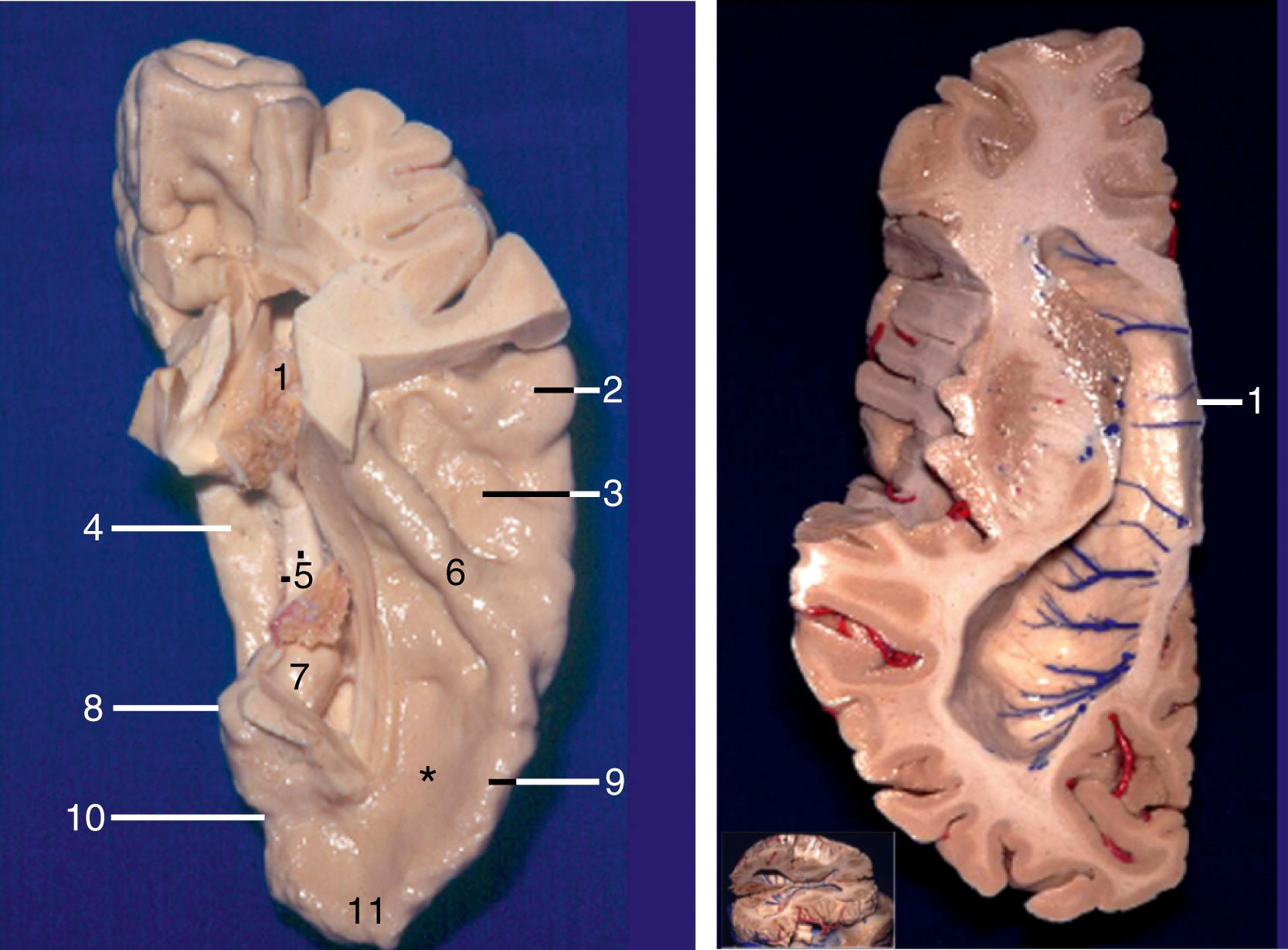
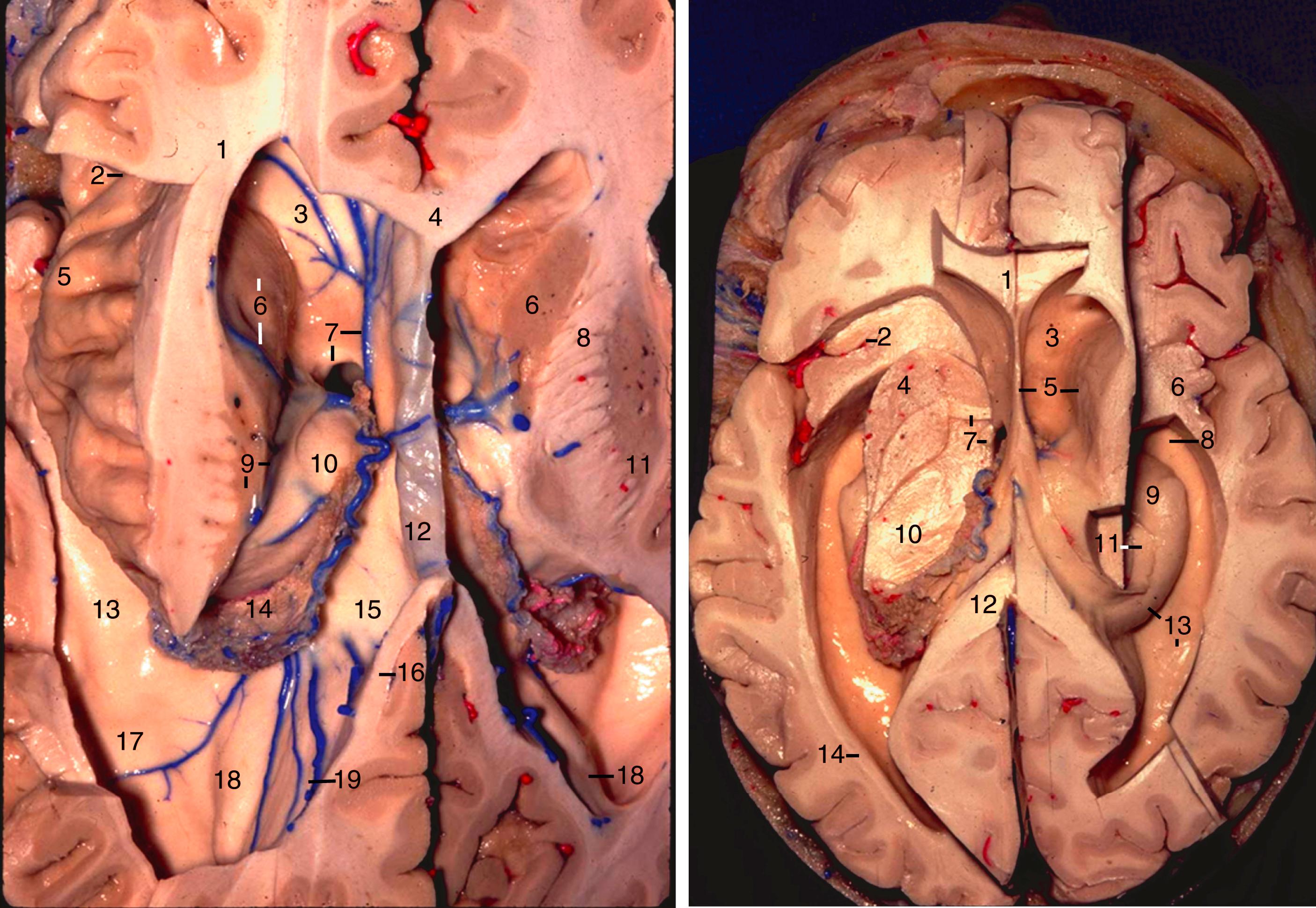
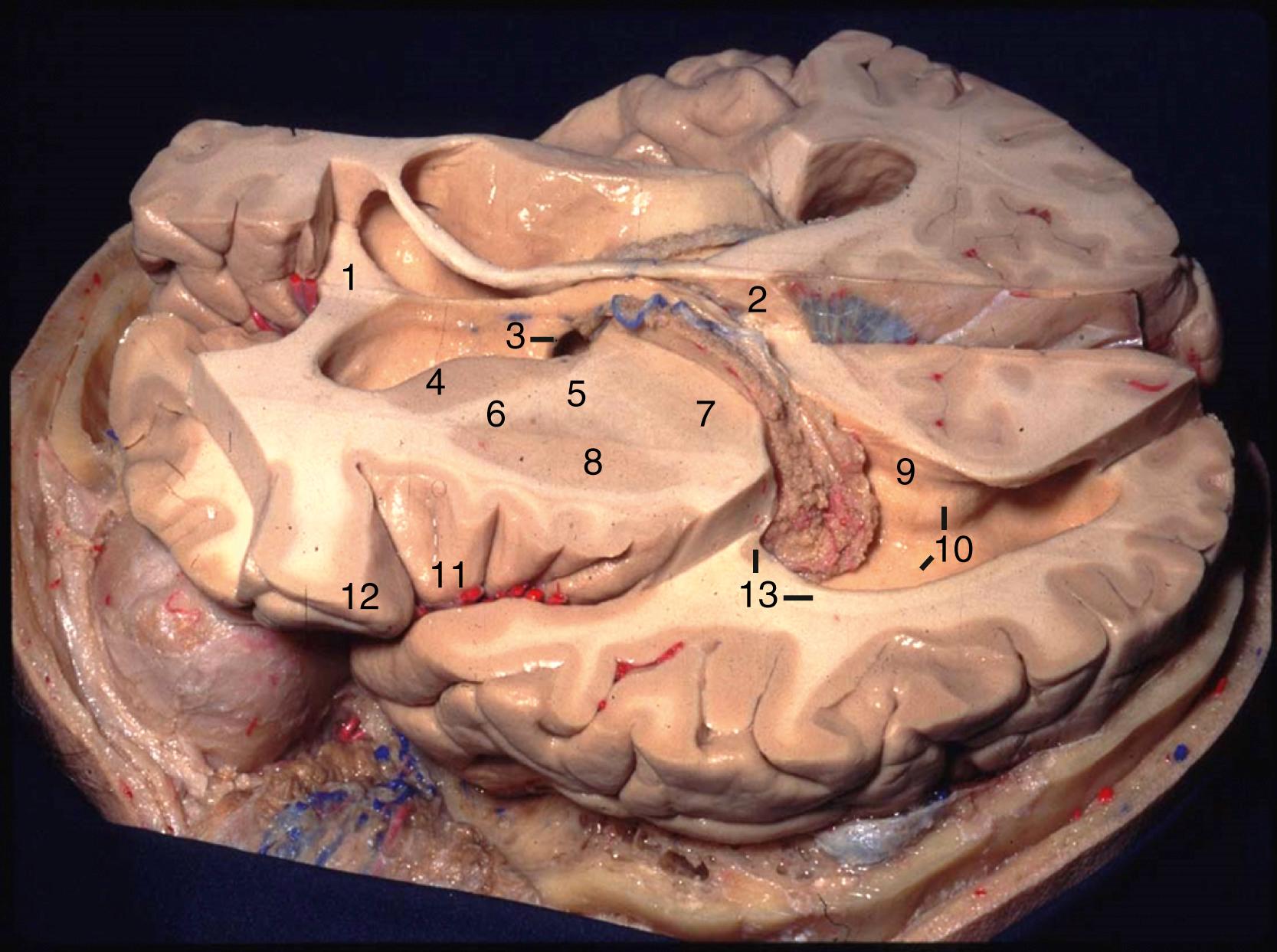
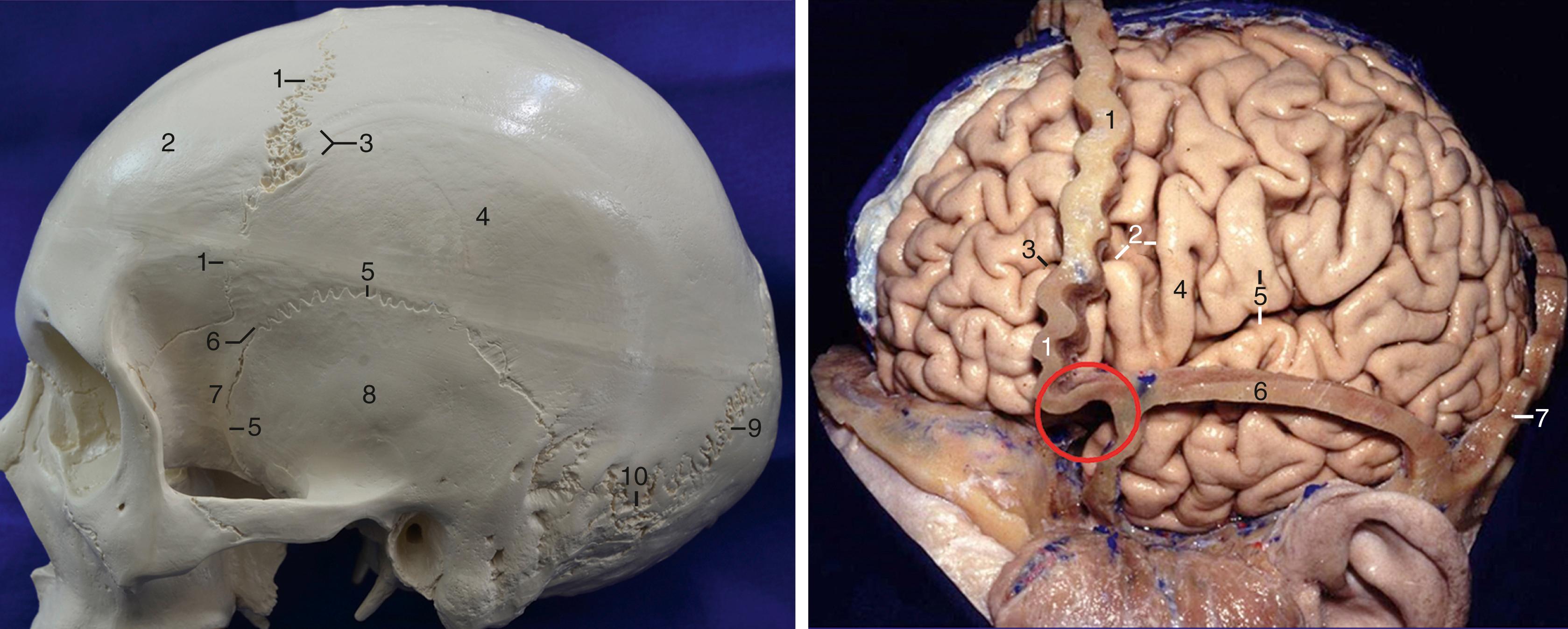
The insula has the shape of a pyramid with its apex directed inferiorly and presents an anterior surface and a lateral surface. The anterior surface presents a triangular shape and is constituted by the transverse and accessory gyri, and the insular pole (see Fig. 2.6 , upper right ). The medial portion of the insular pole is marked by an arched ridge of variable prominence, the limen insulae, which is composed of fibers of uncinate fasciculus covered by a thin layer of gray matter that extends from the anterior end of the long gyrus, passes through the medial part of the insular pole, and ends at the middle of the posterior orbital gyrus. Limen means “threshold,” and the limen insulae is the threshold between the carotid cistern medially and the sylvian fissure laterally (see Fig. 2.6 , left ). The insula is encircled and separated from the opercula by a deep furrow called the circular or limiting sulcus of the insula, which presents three parts: the superior, anterior, and inferior parts (see Fig. 2.6 ; ![]() eFigs. 2.5 and 2.6 ). From the limen insulae the sulci and gyri of the insula are directed superiorly in a radial manner. The deepest sulcus, the central sulcus of the insula, is a constant sulcus that extends upward and backward across the insula in the general line of the central sulcus of the cerebrum. It divides the lateral surface of the insula into a large anterior zone that is divided by several shallow sulci into three to five short gyri and a posterior zone that is formed by anterior and posterior long gyri (
eFigs. 2.5 and 2.6 ). From the limen insulae the sulci and gyri of the insula are directed superiorly in a radial manner. The deepest sulcus, the central sulcus of the insula, is a constant sulcus that extends upward and backward across the insula in the general line of the central sulcus of the cerebrum. It divides the lateral surface of the insula into a large anterior zone that is divided by several shallow sulci into three to five short gyri and a posterior zone that is formed by anterior and posterior long gyri ( ![]() see eFig. 2.6 ; Fig. 2.6 ). The pars triangularis and opercularis cover the anterior half of the lateral surface of the insula, and the opercula of the precentral and postcentral gyri cover the posterior half of the lateral surface of the insula . From microsurgical and radiologic viewpoints, the insula represents the external covering of the central core, constituted by the extreme, external, and internal capsules, the claustrum, basal ganglia, and thalamus (
see eFig. 2.6 ; Fig. 2.6 ). The pars triangularis and opercularis cover the anterior half of the lateral surface of the insula, and the opercula of the precentral and postcentral gyri cover the posterior half of the lateral surface of the insula . From microsurgical and radiologic viewpoints, the insula represents the external covering of the central core, constituted by the extreme, external, and internal capsules, the claustrum, basal ganglia, and thalamus ( ![]() eFigs. 2.5, 2.1, and 2.2 ). The anterior, inferior, and posterior limits of the insula on the lateral projection correspond to the anterior, inferior, and posterior limits of the central core (see Fig. 2.5 ). The upper limit of the central core (caudate nucleus) is higher than the upper limit of the insula (
eFigs. 2.5, 2.1, and 2.2 ). The anterior, inferior, and posterior limits of the insula on the lateral projection correspond to the anterior, inferior, and posterior limits of the central core (see Fig. 2.5 ). The upper limit of the central core (caudate nucleus) is higher than the upper limit of the insula ( ![]() eFig. 2.5 ;
eFig. 2.5 ; ![]() , , , ).
, , , ).
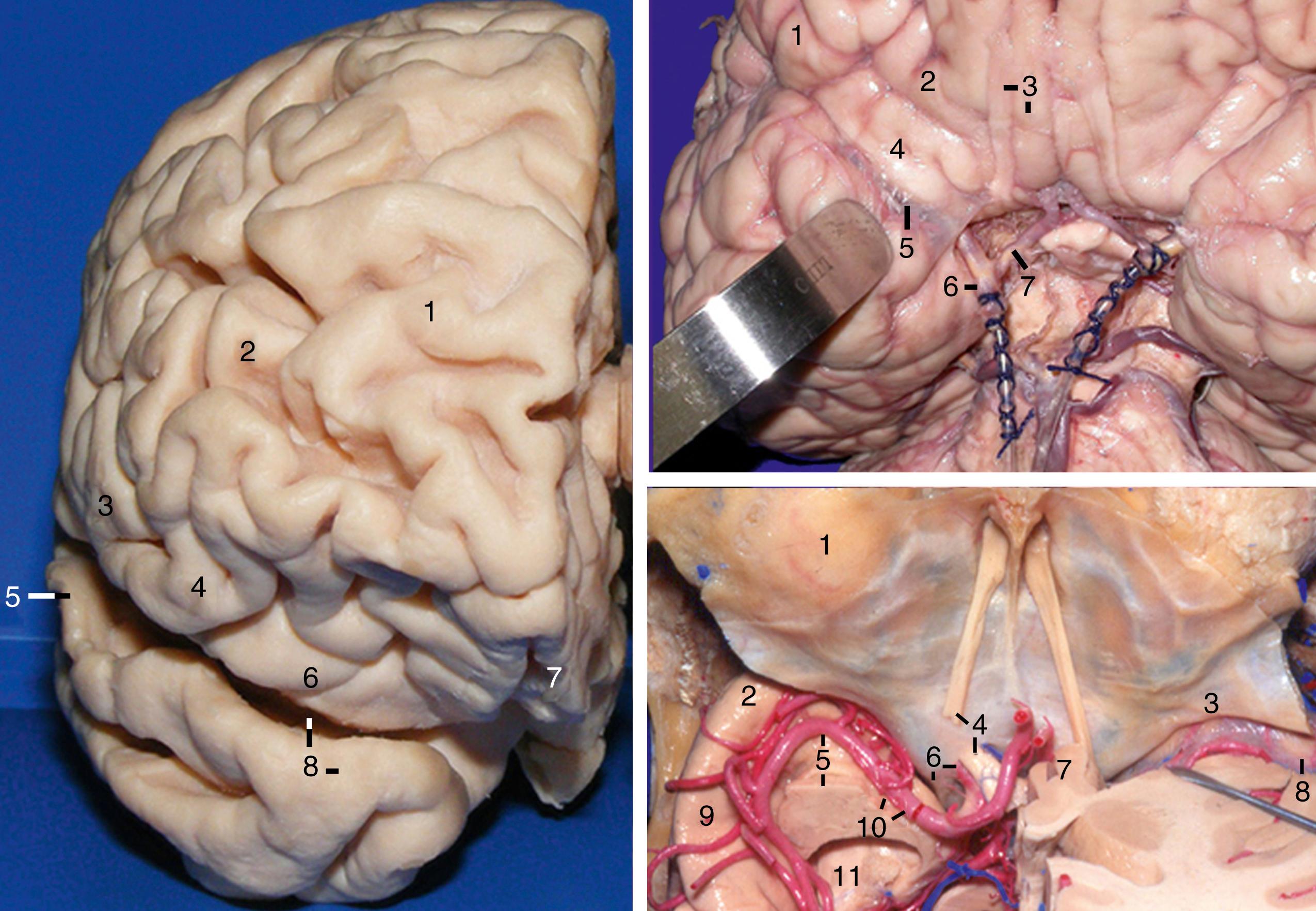
Wrapping around the central core of the hemisphere are the lateral ventricles ( Fig. 2.8 ). Each ventricle has five components: frontal horn, body, atrium, occipital, and temporal horns (five); the corpus callosum constitute the main component of the roof of all five parts (see Fig. 2.7 , right ). The frontal horn is located ahead of the foramen of Monro and presents a roof, a floor, and anterior, lateral, medial, and posterior walls. The transition between the genu and the body of the corpus callosum forms the roof, the rostrum of the corpus callosum forms the narrow floor, the septum pellucidum forms the medial wall, and the thalamus forms the posterior wall. The head of the caudate nucleus forms most of the lateral wall, but the most anterior part is constituted by the anterior isthmus, and it is in close relation to the anterior limiting sulcus of the insula. The body of the lateral ventricle is located behind the foramen of Monro and extends to the point where the septum pellucidum, corpus callosum, and fornix meet. It presents roof, floor, and lateral and medial walls. The body of the corpus callosum forms the roof; the septum pellucidum above and the body of the fornix below form the medial wall; the body of the caudate nucleus forms the lateral wall; and the thalamus forms the floor. The caudate nucleus and the thalamus are separated by the striothalamic sulcus, the groove in which the stria terminalis and the thalamostriate vein course. The atrium has a roof, a floor, and anterior, medial, and lateral walls. The roof is formed by the body, splenium, and tapetum of the corpus callosum; the floor is formed by the collateral trigone, a triangular area that bulges upward over the posterior end of the collateral sulcus ( ![]() eFig. 2.1 ). The medial wall is formed by two roughly horizontal prominences: the upper prominence, the bulb of the callosum, is formed by the large bundle of fibers called the forceps major that connects the two occipital lobes; the lower prominence, the calcar avis, overlies the deepest part of the calcarine sulcus. The lateral wall has an anterior part formed by the caudate nucleus as it wraps the lateral margin of the pulvinar, and a posterior part formed by the fibers of the tapetum as they sweep anteroinferiorly along the lateral margin of the ventricle and separate the ventricular cavity from the optic radiation. The anterior wall has a medial part composed of the crus of the fornix as it wraps the posterior part of the pulvinar, and a lateral part formed by the pulvinar of the thalamus. The occipital horn extends posteriorly into the occipital lobe from the atrium. It varies from being absent to extending far posteriorly in the occipital lobe. The bulb of the callosum and the calcar avis form its medial wall; the tapetum forms the roof and the lateral wall; and the collateral trigone forms the floor (
eFig. 2.1 ). The medial wall is formed by two roughly horizontal prominences: the upper prominence, the bulb of the callosum, is formed by the large bundle of fibers called the forceps major that connects the two occipital lobes; the lower prominence, the calcar avis, overlies the deepest part of the calcarine sulcus. The lateral wall has an anterior part formed by the caudate nucleus as it wraps the lateral margin of the pulvinar, and a posterior part formed by the fibers of the tapetum as they sweep anteroinferiorly along the lateral margin of the ventricle and separate the ventricular cavity from the optic radiation. The anterior wall has a medial part composed of the crus of the fornix as it wraps the posterior part of the pulvinar, and a lateral part formed by the pulvinar of the thalamus. The occipital horn extends posteriorly into the occipital lobe from the atrium. It varies from being absent to extending far posteriorly in the occipital lobe. The bulb of the callosum and the calcar avis form its medial wall; the tapetum forms the roof and the lateral wall; and the collateral trigone forms the floor ( ![]() eFigs. 2.2 and 2.7 ). The temporal horn extends forward and inferiorly from the atrium into the medial part of the temporal lobe and presents roof, floor, and anterior, lateral, and medial walls (
eFigs. 2.2 and 2.7 ). The temporal horn extends forward and inferiorly from the atrium into the medial part of the temporal lobe and presents roof, floor, and anterior, lateral, and medial walls ( ![]() eFig. 2.7 ). The tapetum, the tail of the caudate nucleus, part of the retrolentiform and sublentiform components of the internal capsule, and the amygdaloid nucleus form the roof. The retrolentiform component is the posterior thalamic radiation that includes the optic radiation (see Fig. 2.11 ;
eFig. 2.7 ). The tapetum, the tail of the caudate nucleus, part of the retrolentiform and sublentiform components of the internal capsule, and the amygdaloid nucleus form the roof. The retrolentiform component is the posterior thalamic radiation that includes the optic radiation (see Fig. 2.11 ; ![]() eFig. 2.8 ); the sublentiform component is formed mainly by the acoustic radiation (see Fig. 2.10 ). The amygdaloid nucleus constitutes the most anterior part of the roof of the temporal horn and is located above and in front of the head of the hippocampus (
eFig. 2.8 ); the sublentiform component is formed mainly by the acoustic radiation (see Fig. 2.10 ). The amygdaloid nucleus constitutes the most anterior part of the roof of the temporal horn and is located above and in front of the head of the hippocampus ( ![]() eFigs. 2.9, 2.5, and 2.7 ), anterior to the inferior choroidal point, which is the most anterior site of attachment of the choroid plexus in the temporal horn ( Fig. 2.9 ;
eFigs. 2.9, 2.5, and 2.7 ), anterior to the inferior choroidal point, which is the most anterior site of attachment of the choroid plexus in the temporal horn ( Fig. 2.9 ; ![]() eFigs. 2.7 and 2.9 , right ). There is no clear separation between the roof of the temporal horn and the thalamus because all fibers of the optic radiation come from the lateral geniculate body, which is part of thalamus. Therefore it is reasonable to consider the roof of the temporal horn as a lateral extension of the thalamus (
eFigs. 2.7 and 2.9 , right ). There is no clear separation between the roof of the temporal horn and the thalamus because all fibers of the optic radiation come from the lateral geniculate body, which is part of thalamus. Therefore it is reasonable to consider the roof of the temporal horn as a lateral extension of the thalamus ( ![]() eFig. 2.9 , right ). The attachment site of the choroid plexus can be a surgical landmark to separate the thalamus from the roof of the temporal horn (see Fig. 2.9 , right ;
eFig. 2.9 , right ). The attachment site of the choroid plexus can be a surgical landmark to separate the thalamus from the roof of the temporal horn (see Fig. 2.9 , right ; ![]() eFig. 2.9 , right ). The tapetum and the optic radiation form the lateral wall ( Fig. 2.10 ;
eFig. 2.9 , right ). The tapetum and the optic radiation form the lateral wall ( Fig. 2.10 ; ![]() eFigs. 2.2 and 2.9 ); the amygdaloid body forms the anterior wall; the head of the hippocampus forms the anterior third of the medial wall; and the choroidal fissure forms the posterior two-thirds (see Figs. 2.7 , left, and 2.9;
eFigs. 2.2 and 2.9 ); the amygdaloid body forms the anterior wall; the head of the hippocampus forms the anterior third of the medial wall; and the choroidal fissure forms the posterior two-thirds (see Figs. 2.7 , left, and 2.9; ![]() eFigs. 2.1, right, 2.5, 2.7, and 2.9 ). The floor is formed medially by the hippocampus and laterally by the collateral eminence (see Figs. 2.7 , left, 2.8, and 2.9;
eFigs. 2.1, right, 2.5, 2.7, and 2.9 ). The floor is formed medially by the hippocampus and laterally by the collateral eminence (see Figs. 2.7 , left, 2.8, and 2.9; ![]() eFigs. 2.1, 2.5, and 2.7 ). The temporal horn is projected onto the middle temporal gyrus on the lateral view.
eFigs. 2.1, 2.5, and 2.7 ). The temporal horn is projected onto the middle temporal gyrus on the lateral view.
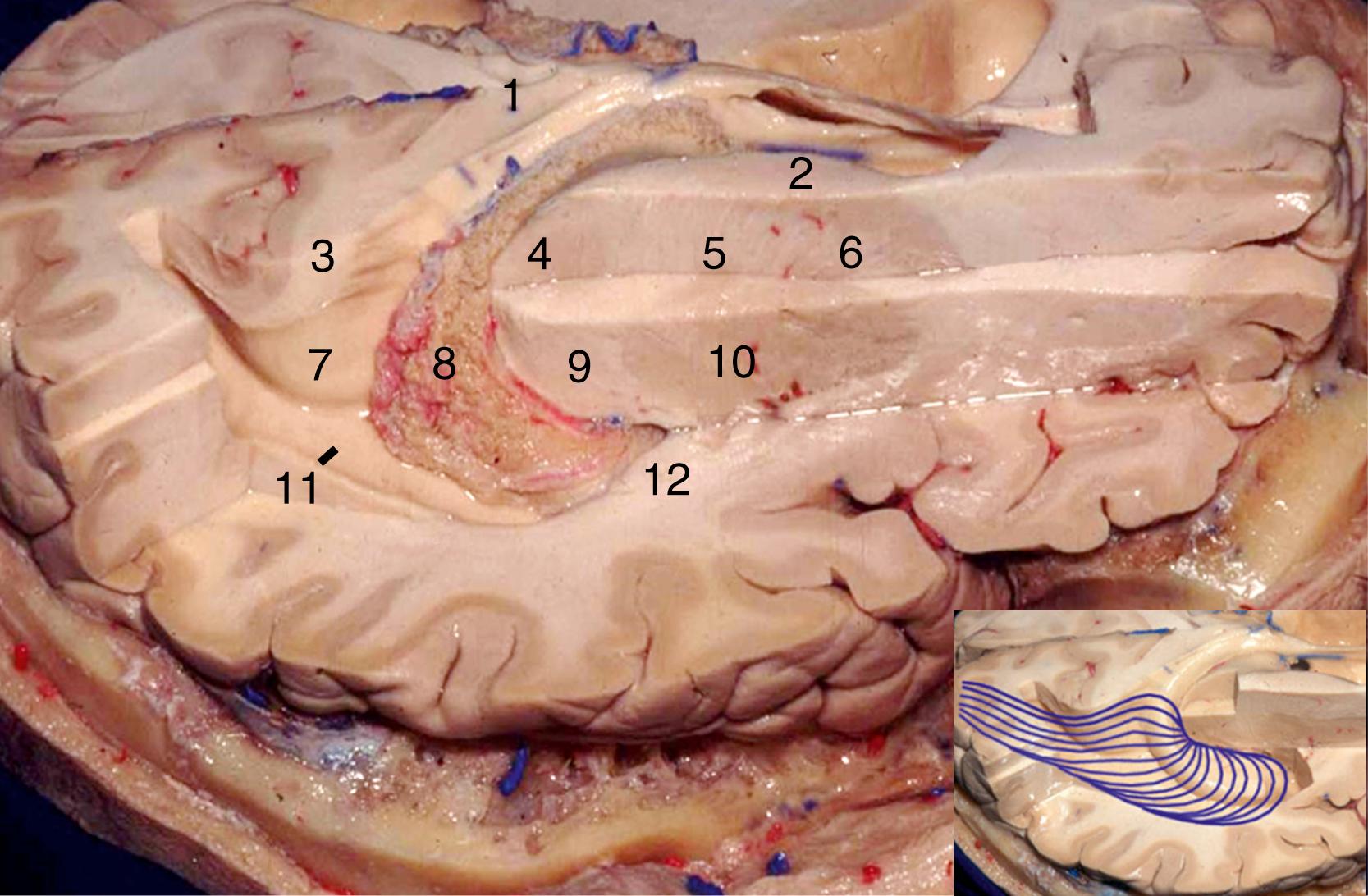
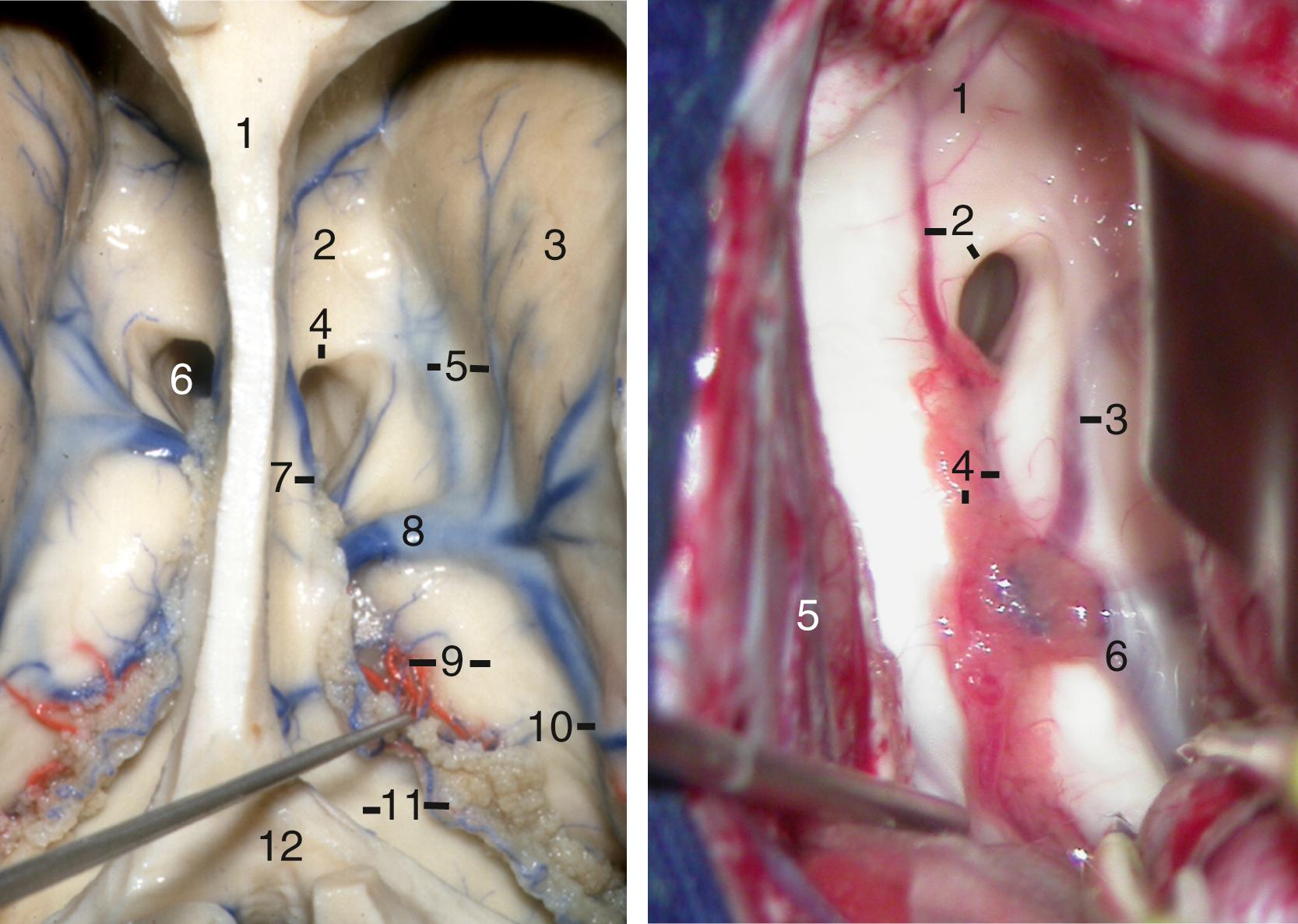
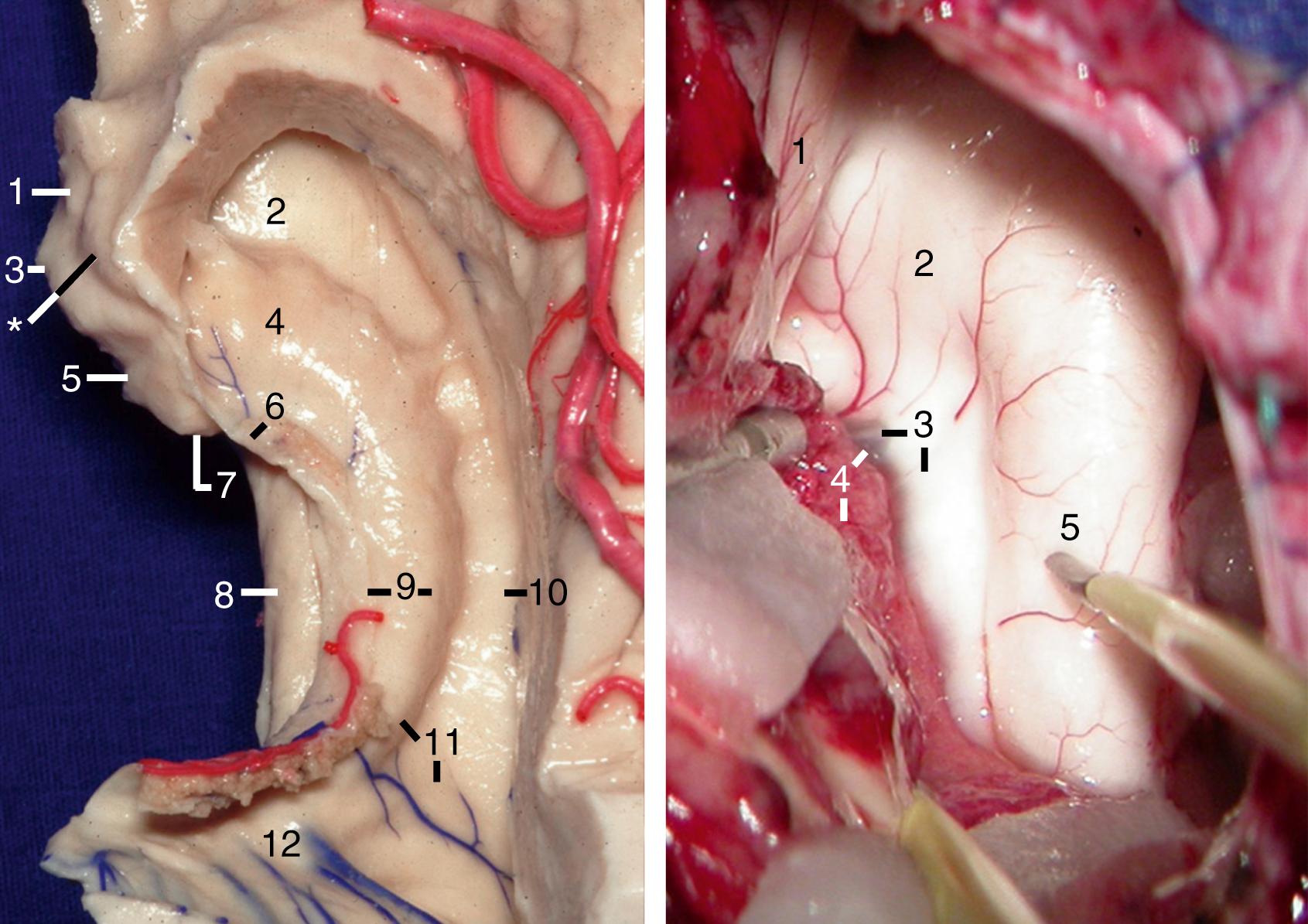
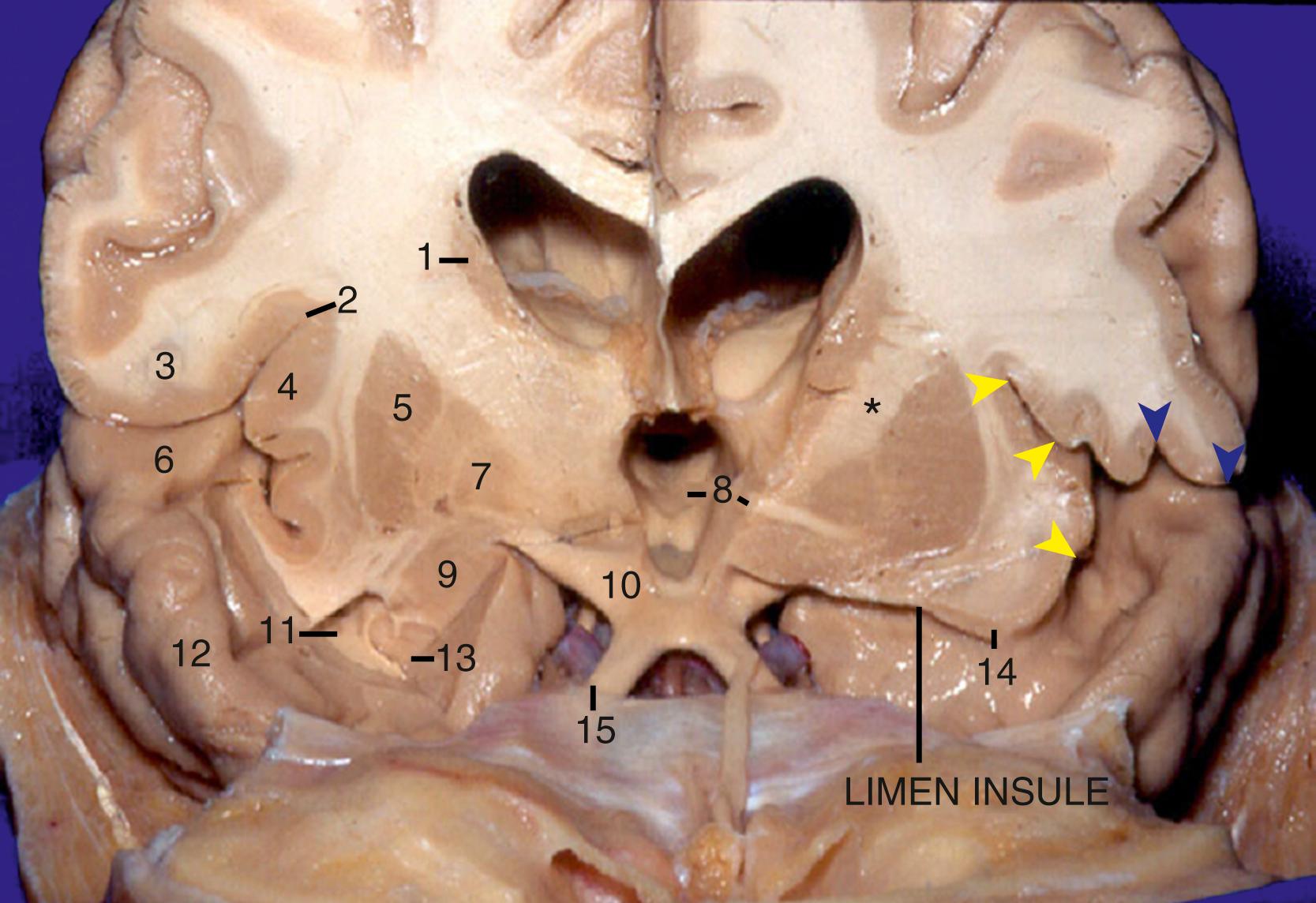
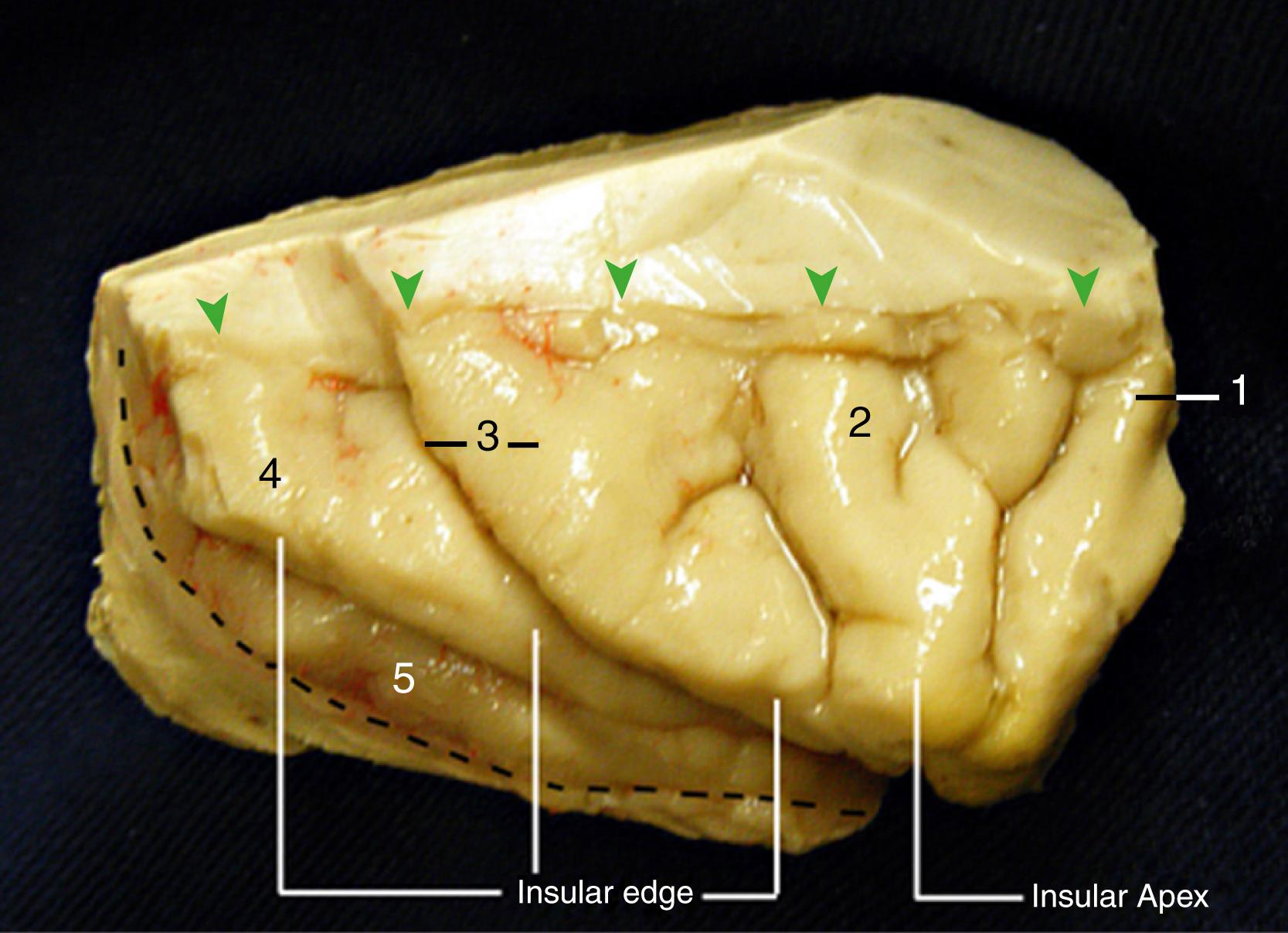
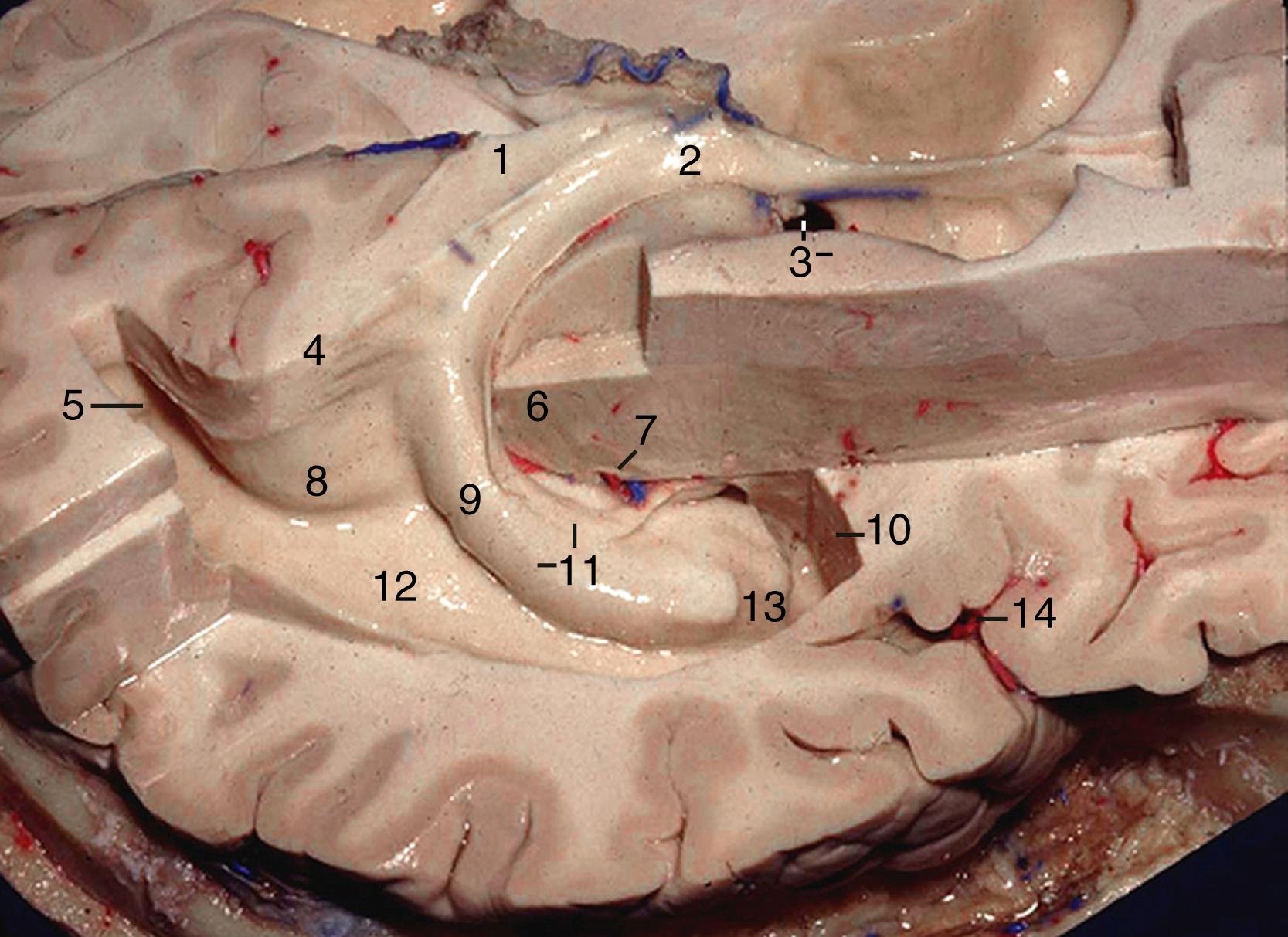
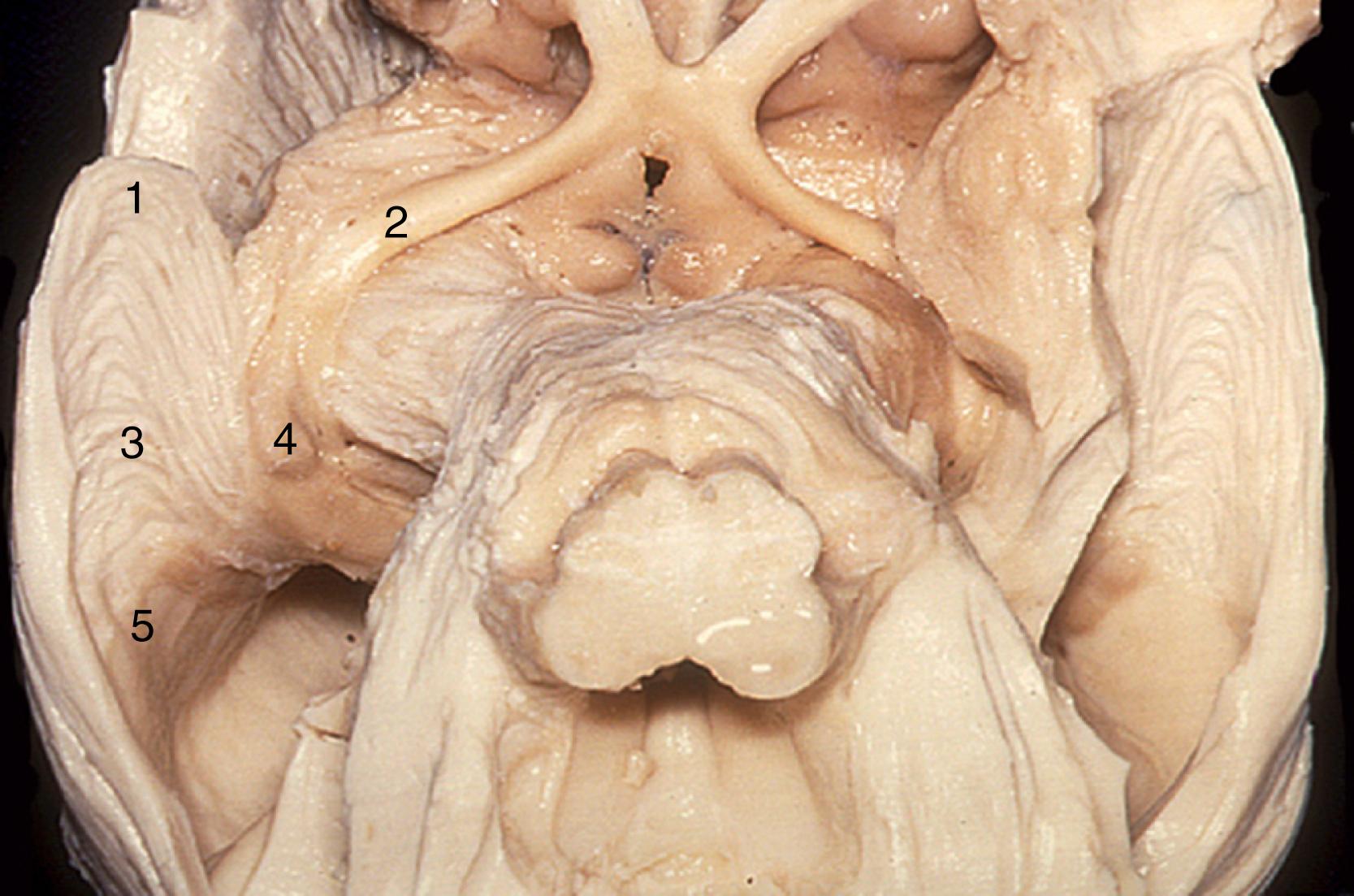
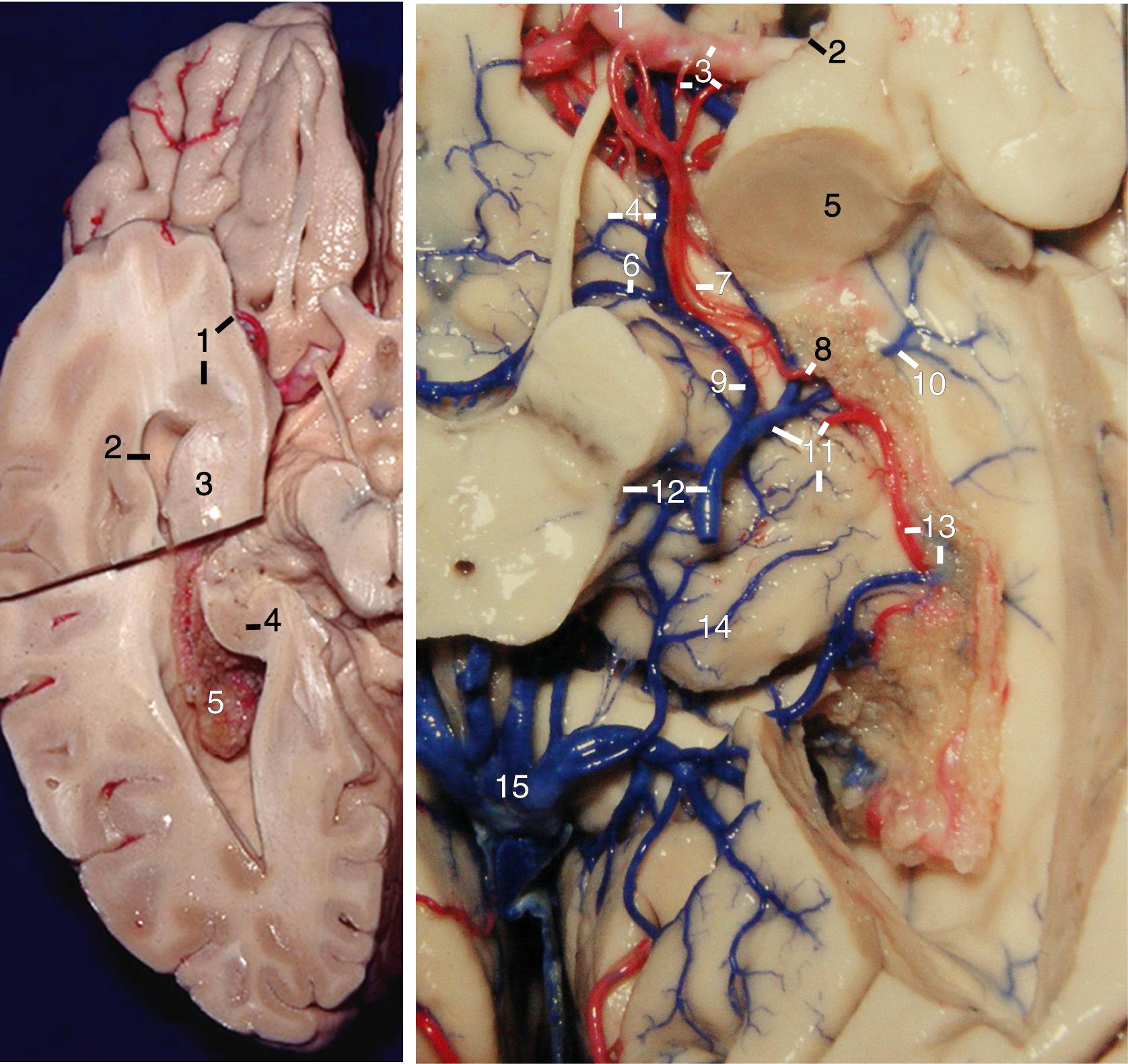
The structures related to the lateral ventricle are foramen of Monro, internal capsule, corpus callosum, fornix, thalamus, caudate nucleus, hippocampus, temporal amygdala, and choroidal fissure ( ![]() , , ).
, , ).
The foramen of Monro communicates the lateral ventricle to the third ventricle. It usually presents a crescent shape and is bounded anteriorly and superiorly by the columns of the fornix and posteriorly by the thalamus. The elements that run close to the foramen of Monro are the anterior septal vein superiorly and medially, the choroidal plexus posteriorly and medially, and the thalamostriate vein laterally and posteriorly (see Figs. 2.10, 2.5, and 2.8 ; ![]() eFigs. 2.1, 2.2, and 2.7 ).
eFigs. 2.1, 2.2, and 2.7 ).
The internal capsule has five parts: the anterior and posterior limbs, the genu, the retrolentiform, and the sublentiform parts. The anterior limb is located between the head of the caudate nucleus and the anterior half of the lentiform nucleus and contains frontopontine fibers; the posterior limb is located between the thalamus and the posterior half of the lentiform nucleus and contains the corticospinal tract, corticotegmental and thalamopostcentral (posterior fibers of the superior thalamic peduncle also referred as the somaesthesic radiation). The genu comes to the ventricular surface immediately lateral to the foramen of Monro in the interval between the caudate nucleus and the thalamus, where the thalamostriate vein usually drains into the internal cerebral vein; the genu contains fibers that connect the precentral cortex with the motor nuclei of the cranial nerves (CNs) and the thalamoprecentral and thalamoprefrontal fibers (anterior fibers of the superior thalamic peduncle). The retrolentiform part is located posteriorly to the lentiform nucleus and contains mainly parietopontine, occipitopontine, occipitocollicular, and occipitotectal fibers and the posterior thalamic radiation that includes the optic radiation. The sublentiform part is located below the lentiform nucleus and contains temporopontine and parietopontine fibers, and acoustic radiation from the medial geniculate body to the superior temporal gyrus and to the transverse temporal gyri ( Figs. 2.11 and 2.5 ; ![]() eFigs. 2.1, 2.2, and 2.5 ).
eFigs. 2.1, 2.2, and 2.5 ).
The corpus callosum (“tough body”) is the largest transverse commissure connecting the cerebral hemispheres. It contributes to the wall of each of the five parts of the lateral ventricle. Within each cerebral hemisphere, its fibers open like a fan or the flapping of wings of a butterfly toward all the lobes forming the callosal radiation. The corpus callosum is divided into four parts: rostrum, genu, body, and splenium. The rostrum is the floor of the frontal horn. The genu gives rise to a large fiber tract, the forceps minor, which forms the anterior wall of the frontal horn, and the genu connects the frontal lobes. The splenium gives rise to a large tract, the forceps major, which forms a prominence called bulb of callosum in the upper part of the medial wall of the atrium and occipital horn as it sweeps posteriorly to connect the occipital lobes. Another fiber tract, the tapetum, arises in the posterior part of the body and splenium and sweeps laterally and inferiorly to form the roof and lateral wall of the atrium and the temporal and occipital horns (see Figs. 2.5, 2.7 , right, 2.10, and 2.11; ![]() eFigs. 2.1, 2.2, and 2.7 ;
eFigs. 2.1, 2.2, and 2.7 ; ![]() ).
).
The optic radiation is a bundle of fibers that extend from the lateral geniculate body to the visual area in the occipital lobe. The optic radiation may be divided into three parts: anterior, middle, and posterior. In the anterior part the fibers initially take an anterior direction along the roof of the temporal horn, usually reaching as far anteriorly as the tip of the temporal horn, and then loop backward in the lateral and inferior aspects of the atrium and the occipital horn to end in the lower lip of the calcarine fissure; this anterior loop is called the Meyer loop. The anterior part represents the upper quadrants of the visual field. In the middle part the fibers take a lateral direction initially, coursing along the roof of the temporal horn, and then proceed posteriorly along the lateral wall of the atrium and the occipital horn; the middle part contains the macular fibers. The fibers of the posterior part course directly backward along the lateral wall of the atrium and the occipital horn to end in the upper lip of the calcarine fissure; these fibers are responsible for the lower quadrants of the visual field (see Figs. 2.11 and 2.10 ; ![]() eFigs. 2.8 and 2.9 ).
eFigs. 2.8 and 2.9 ).
The fornix is a C-shaped structure that wraps around the thalamus in the wall of the lateral ventricle. The initial portion of the fornix, the fimbria, arises from the alveus, which is the subcortical white matter of the hippocampal allocortex, and thickens along the medial edge of the hippocampus, separated from the dentate gyrus by the fimbrodentate sulcus. The fimbria then passes posteriorly to become the crus of the fornix, representing the subcortical radiation of the hippocampal allocortex. In the atrium the crus wraps around the posterior surface of the pulvinar of the thalamus and arches superomedially toward the lower surface of the splenium of the corpus callosum ( Fig. 2.12 ); at the junction between the atrium and the body of the lateral ventricle, the paired crura meet to form the body of the fornix. At the anterior margin of the thalamus, the body of the fornix separates into two columns that arch along the superior and anterior margins of the foramen of Monro. The columns of the fornix then split, passing predominantly posterior to the anterior commissure, and are directed inferiorly and posteriorly through the lateral wall of the third ventricle to reach the mammillary bodies at the floor of the third ventricle. In the area below the splenium, the two crura of the fornix are united by the hippocampal commissure or forniceal commissure or psalterium, which corresponds to an estimated 20% of efferent hippocampal formation fibers forming the fornix (see Figs. 2.8, 2.9, 2.10, 2.11, 2.13, 2.14, and 2.15 , left ; ![]() eFigs. 2.1, 2.2, 2.7, 2.10, and 2.11 ).
eFigs. 2.1, 2.2, 2.7, 2.10, and 2.11 ).
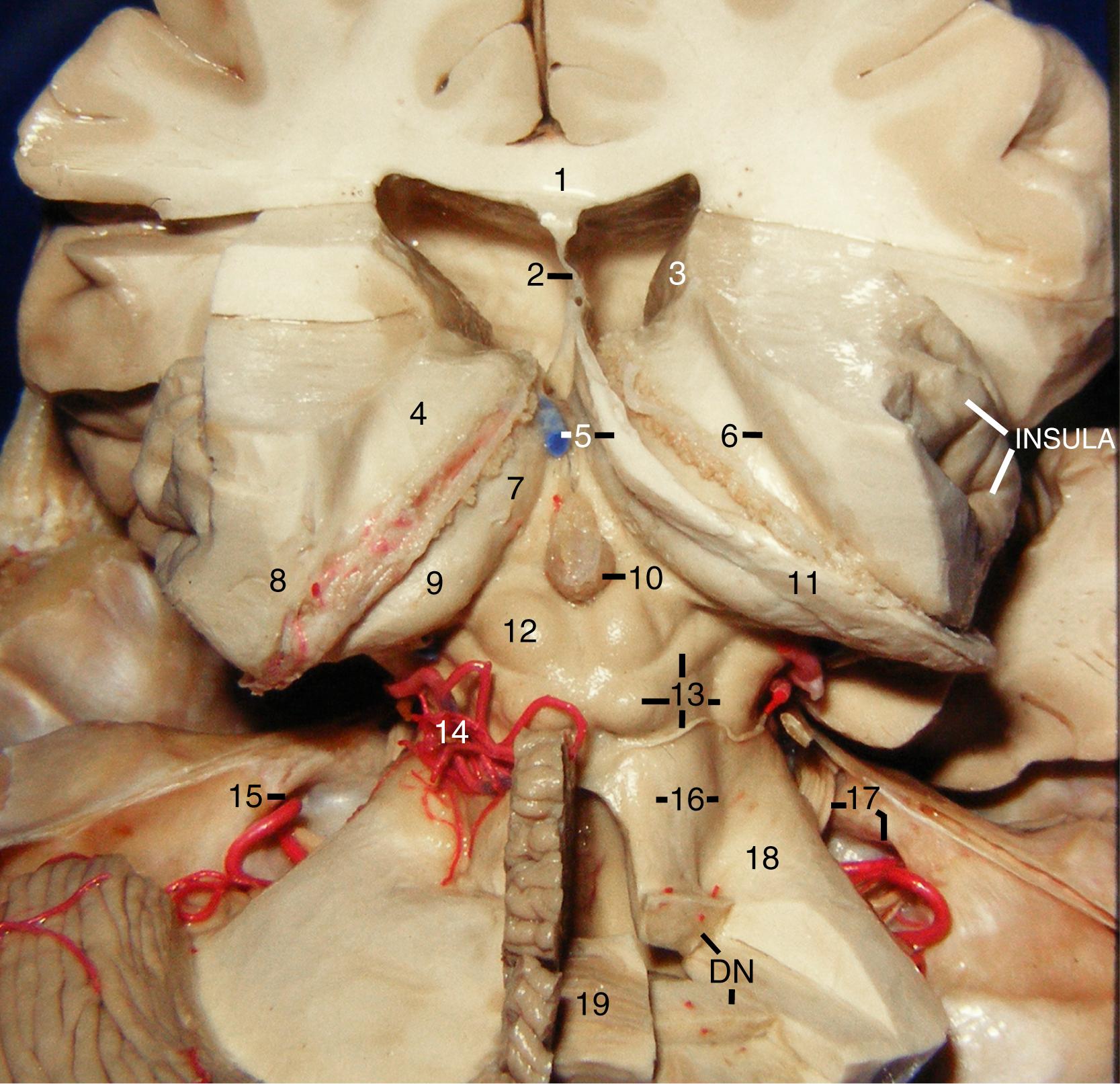
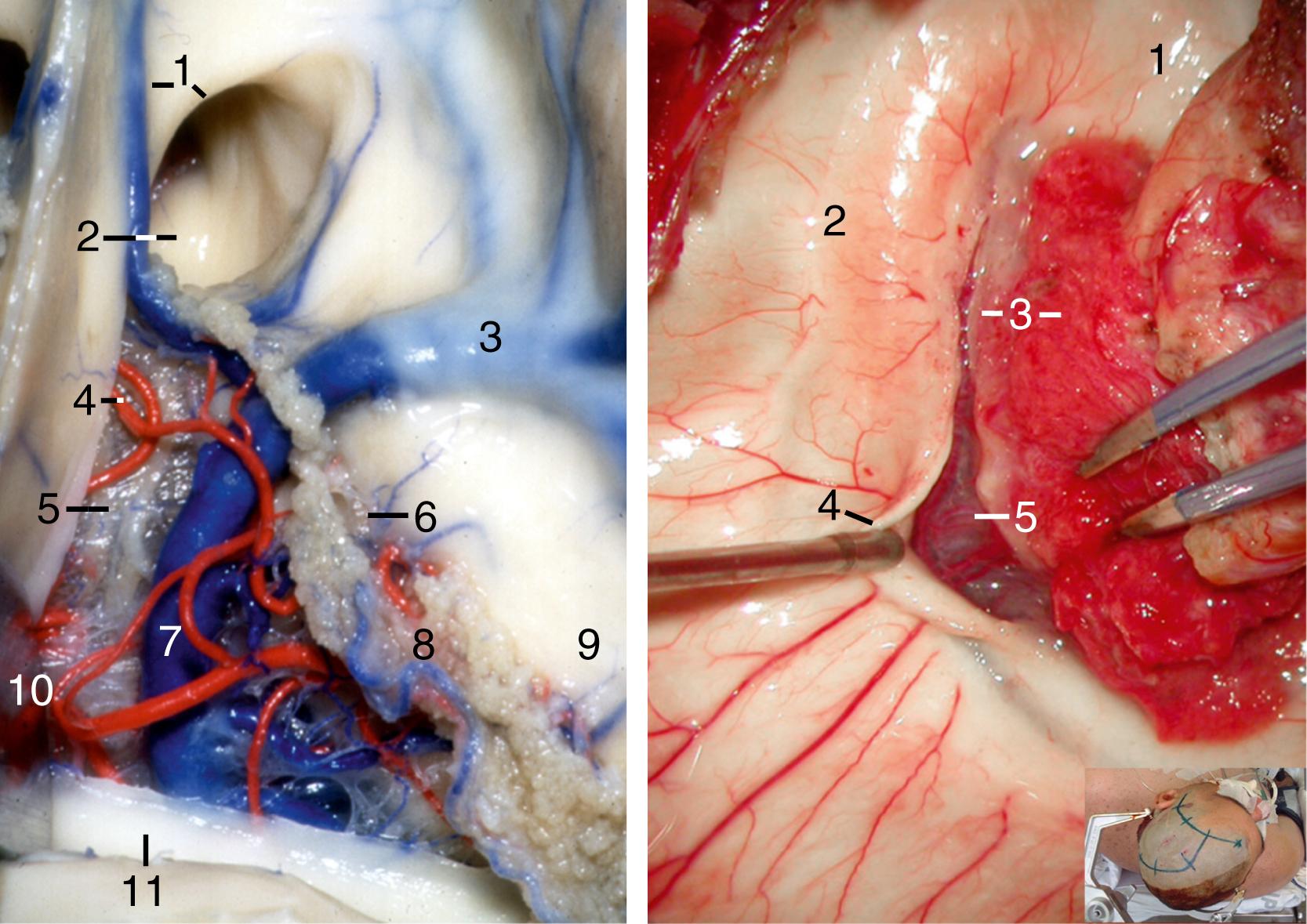
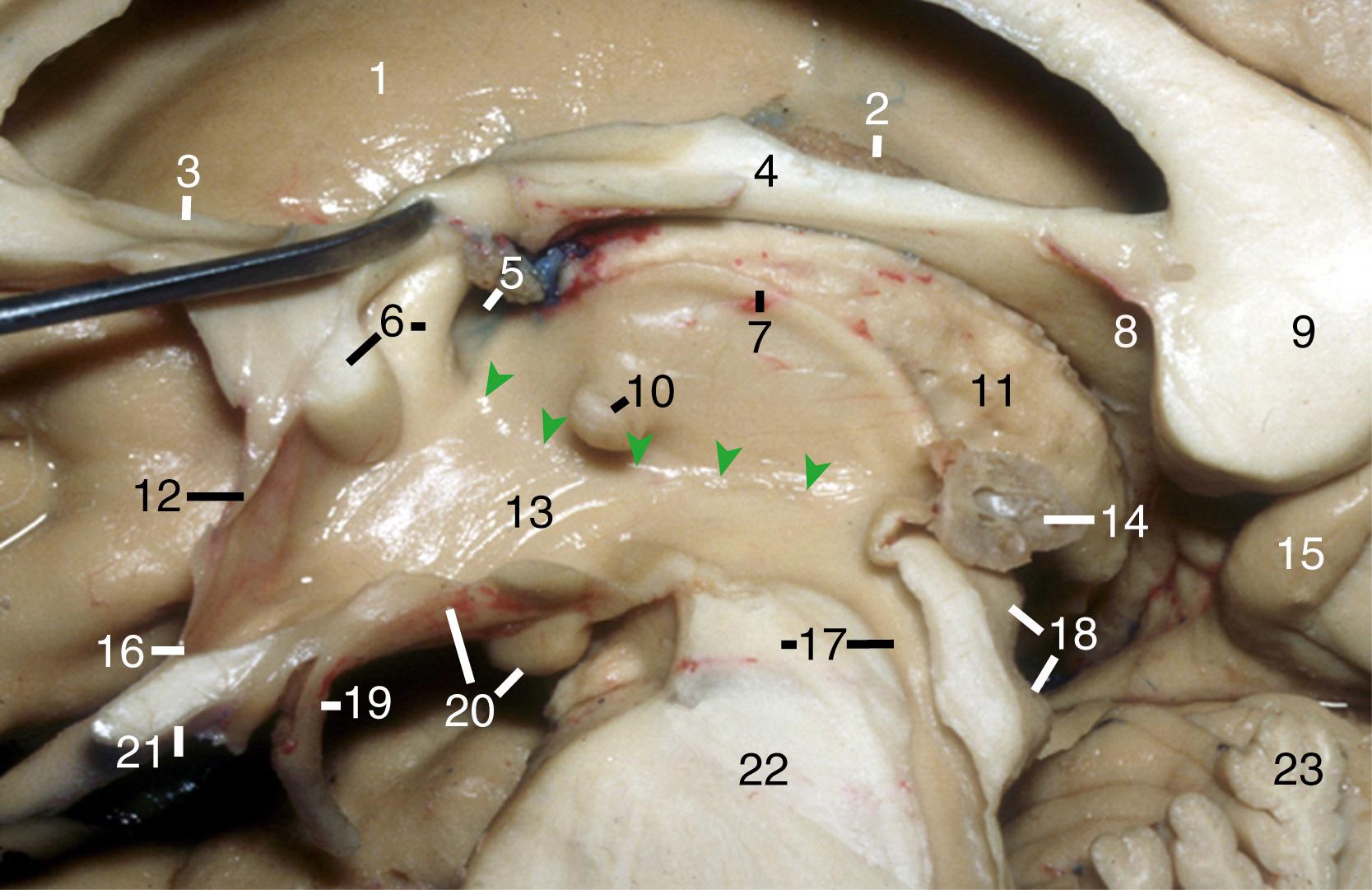
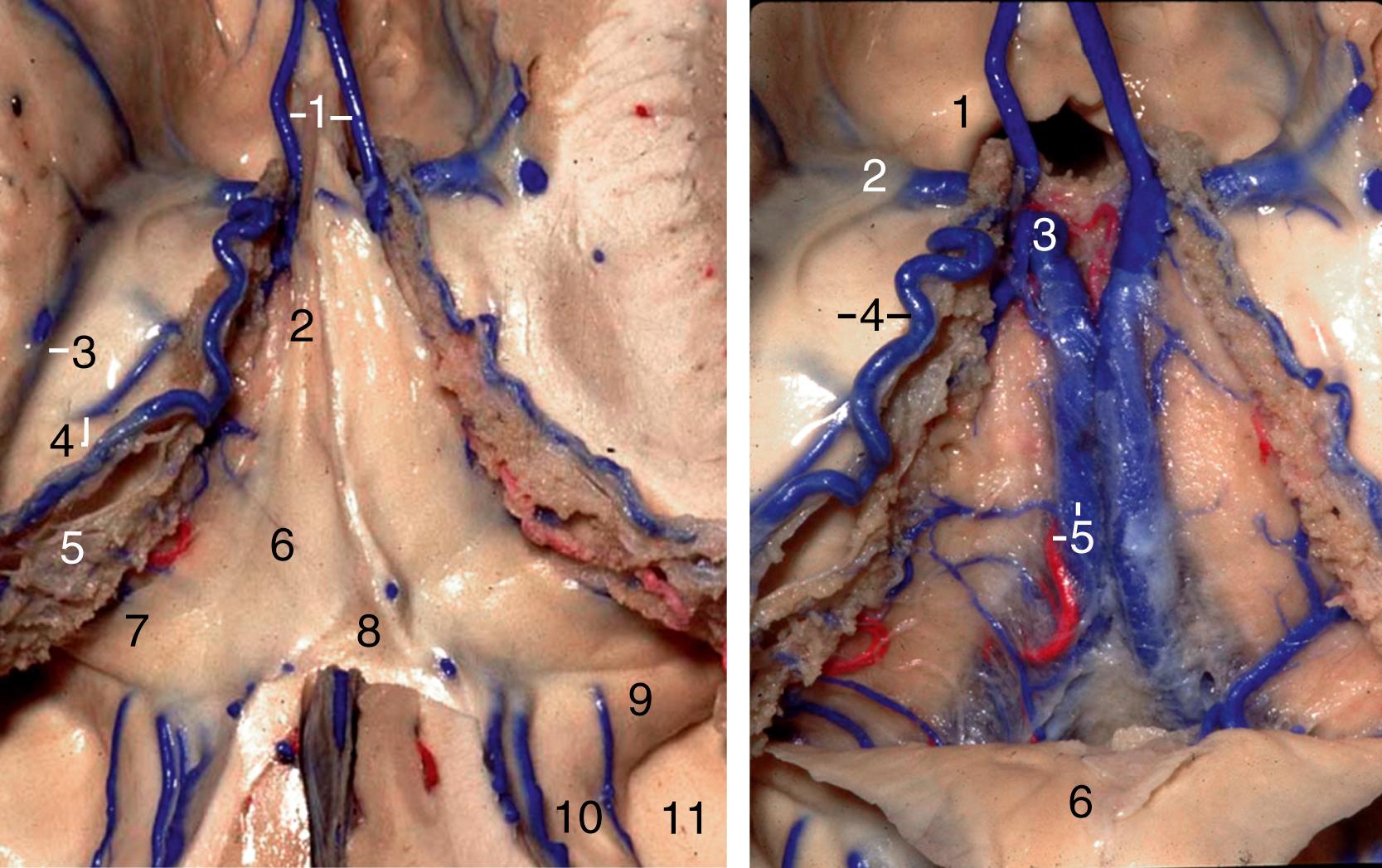
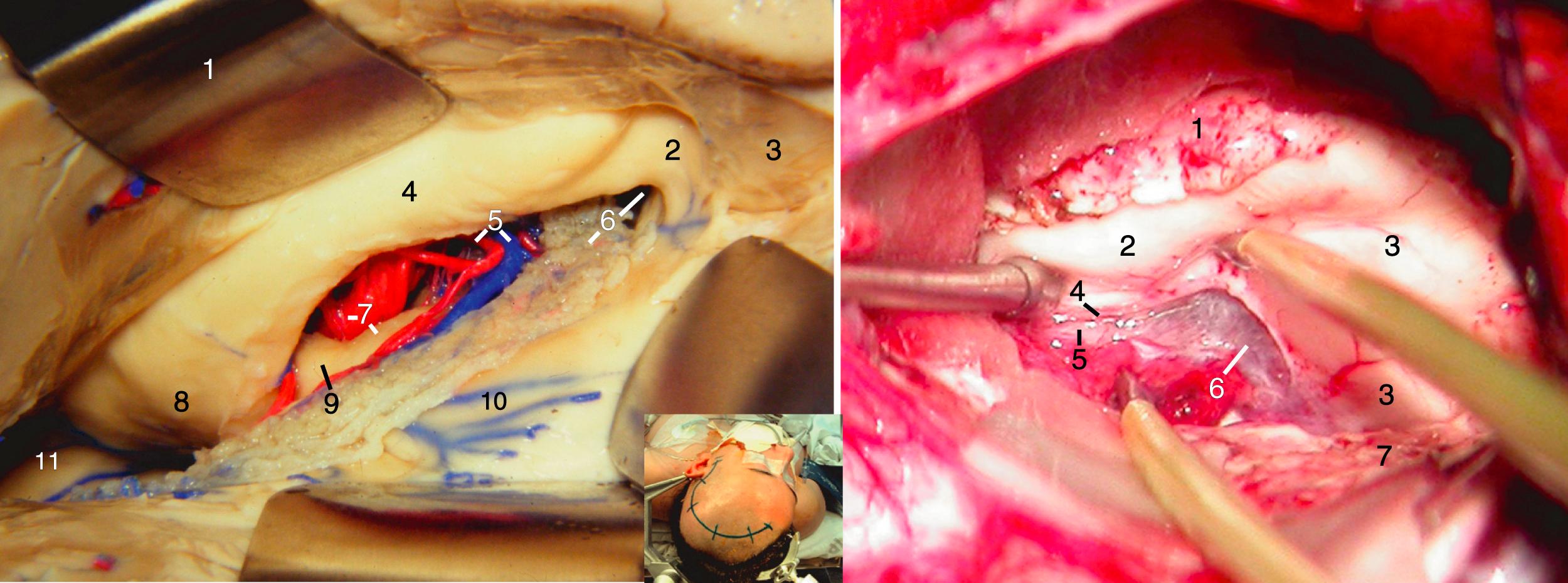
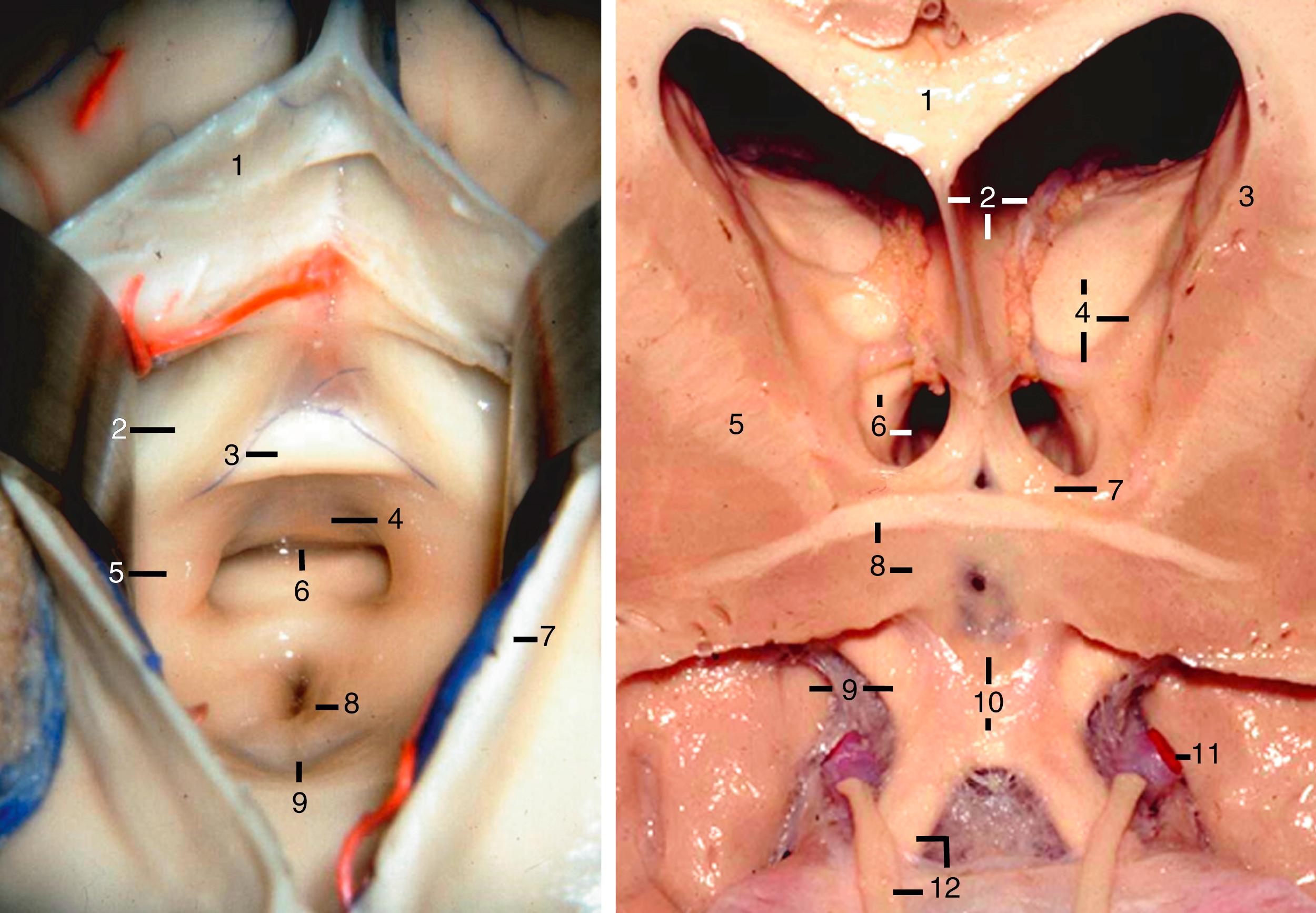
Become a Clinical Tree membership for Full access and enjoy Unlimited articles
If you are a member. Log in here